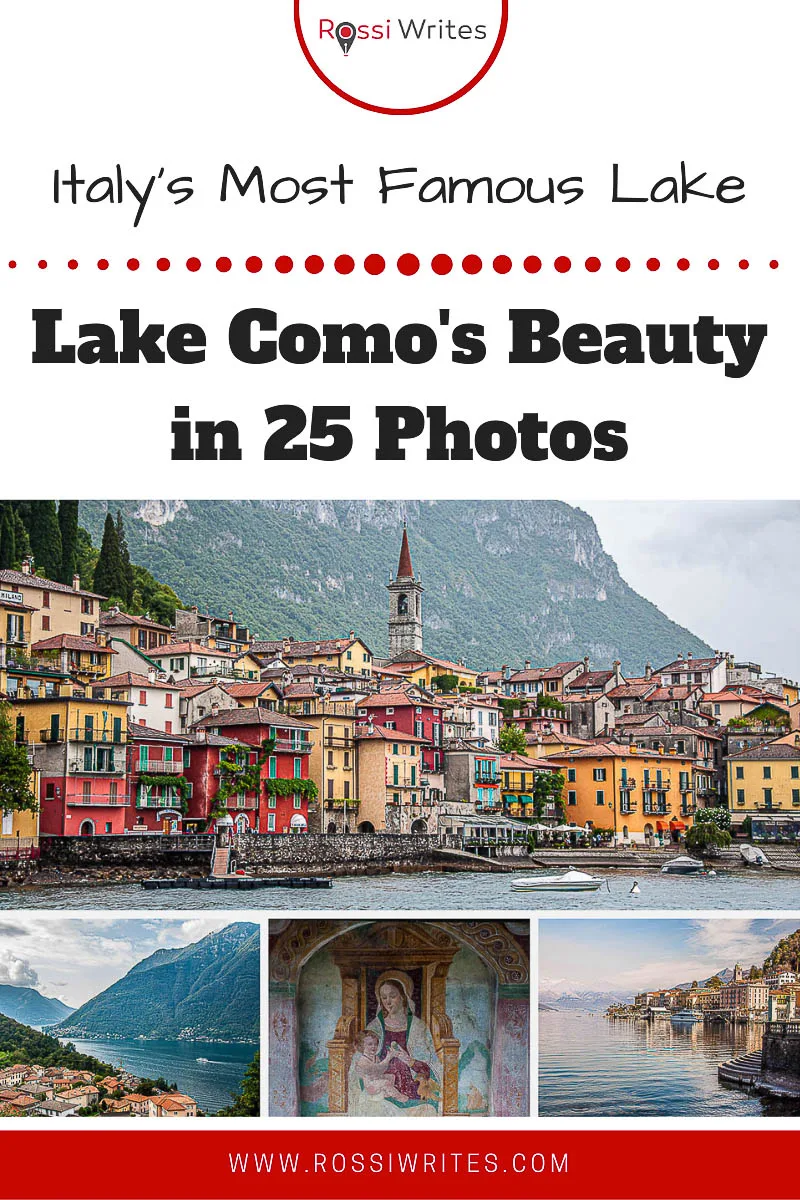Lake Como is Italy’s most famous lake on account of its stunning beauty, unusual upturned Y-shape, and the many celebrities that love spending time on its shores.
Less than an hour away from the fashion capital Milan, and next door to Switzerland, Lake Como is a place of strong contrasts where glitzy and rustic live side by side.
Next to lavish villas and expensive brand shops here you will find unassuming little villages, tiny churches, and hiking paths some of which follow ancient Roman roads.
It’s all enveloped by one of the most striking natural settings this side of Europe. Tall mountains surround Lake Como on all sides, their slopes covered with an impenetrable mesh of deep forests.
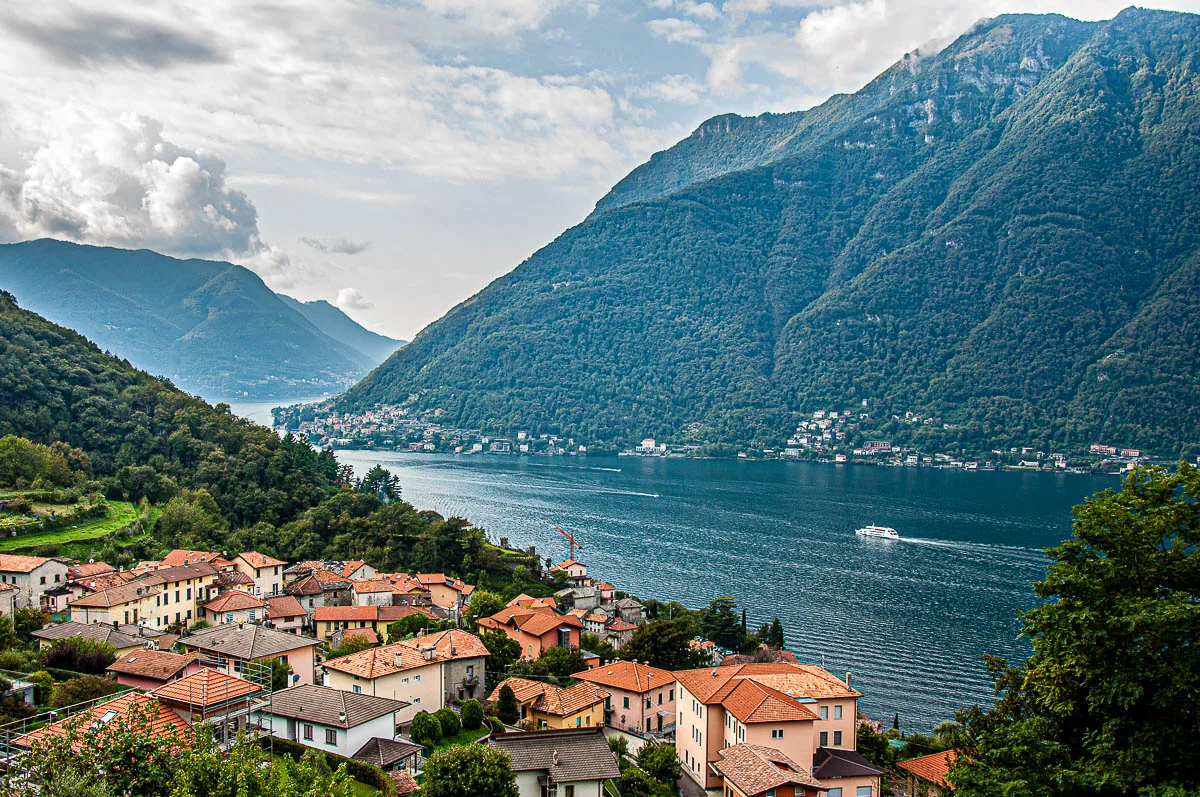
The views are stunning and they have kept attracting people to Lake Como through the centuries. Nowadays, over a million and a half visitors flock to the lakeshores towns each year. Many of them, no doubt, secretly hoping to bump into a famous actor while here.
Well, I may have had similar thoughts once, too. Yet, my own visits to Italy’s Lake Como convinced me that the real leading characters here are the lake itself and the nature that surrounds it.
Made of three elongated branches that form an upturned letter Y, Lake Como captured my imagination. Seen from afar its waters often look completely black only to dissolve in thousands of blues and greens when you get closer. Its steep slopes rush vertiginously straight down to the waterline. Houses cling to them for dear life while town streets are often made of endless stone steps instead of being conventionally flat.
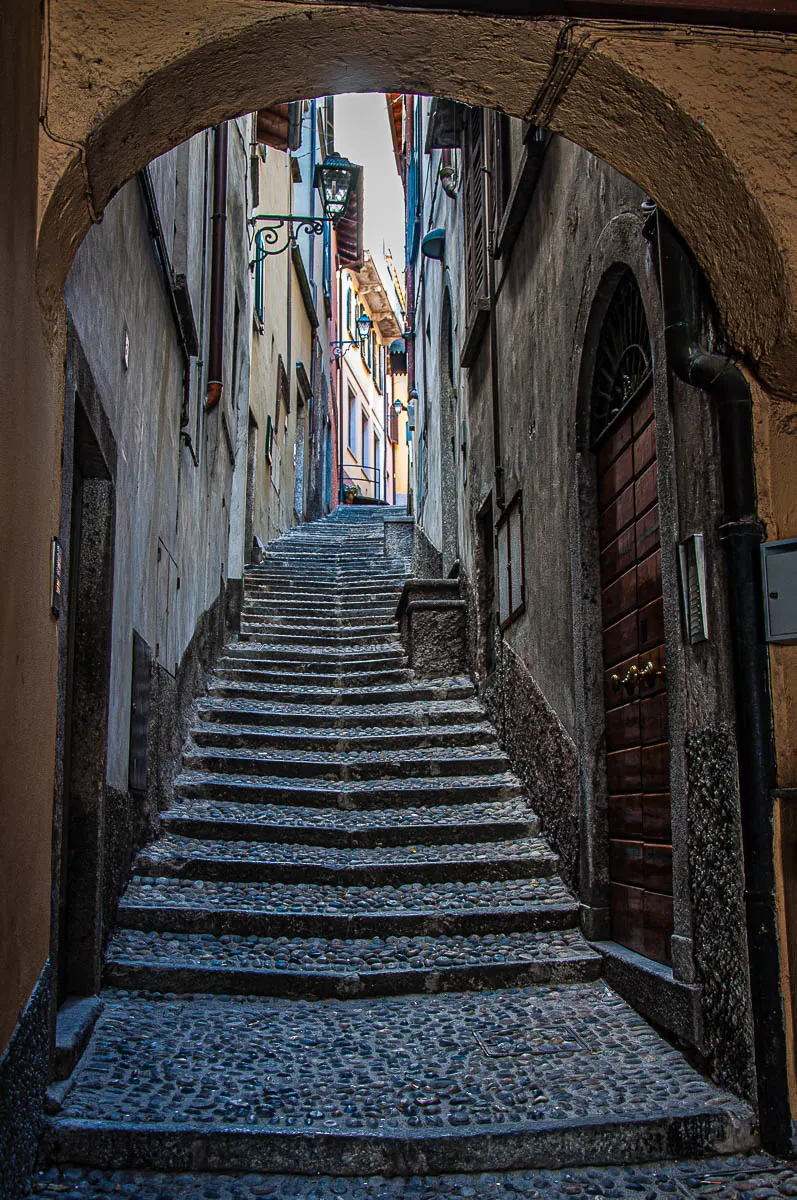
And while a handful of the lakeside towns are internationally famous and host a gaggle of exquisite hotels and fashionable shops, other corners of Lake Como feel very raw and almost completely untouched by the last few decades.
This creates a feeling of great contrasts, of never-ending surprises, of a place where you are in the heart of civilisation and yet right in the centre of nature at its most powerful and indomitable.
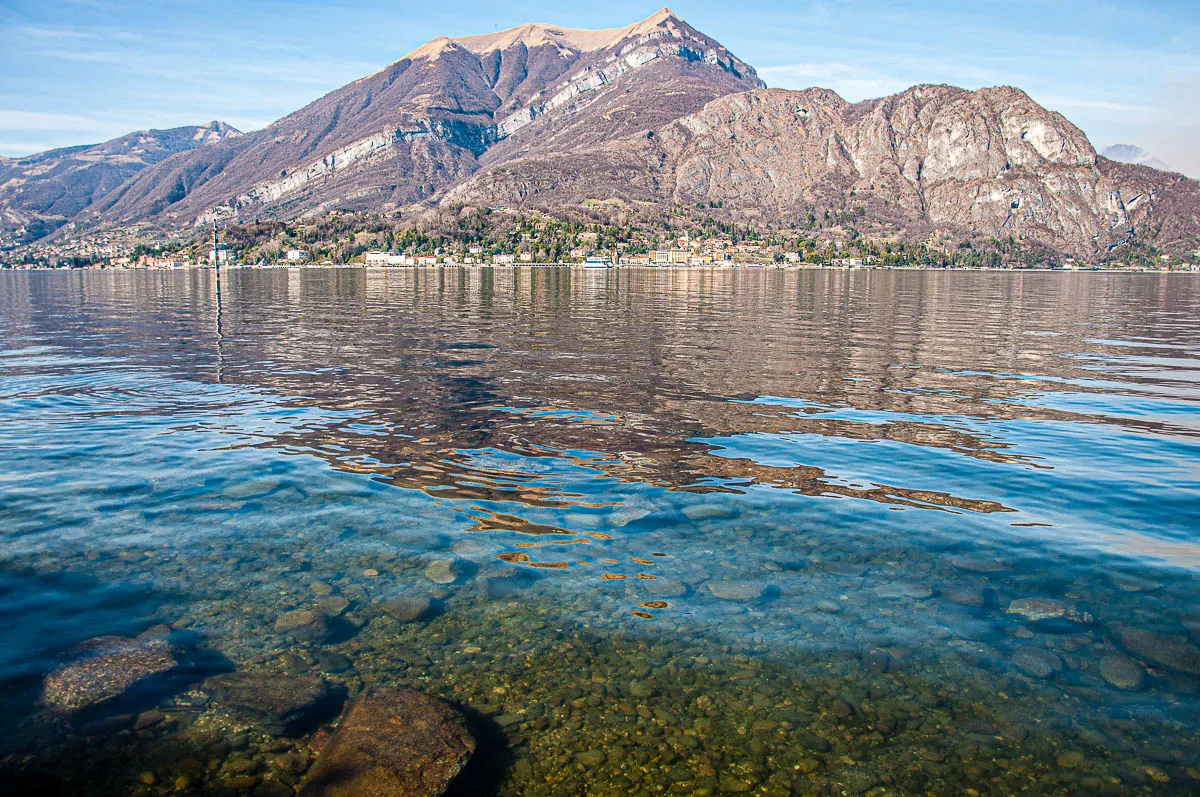
So, today, I want to show you Italy’s Lake Como as I saw it with my eyes and through my camera’s lenses.
Here are 25 photos of this must-see Italian destination. From the lakeside towns – sparkling like gems set against a lush landscape – to the tall rugged mountains that surround Lake Como, from the old step streets made of irregular stones to the houses with peeling doors and whimsical decorations, from the old churches with their ancient statues and frescoes to the myriad colours of the lake waters, here is Italy’s most famous lake totally from my point of view.
I hope that you will enjoy this little photo walk around Lake Como!
Lake Como – The Beauty of Italy’s Most Famous Lake in 25 Photos
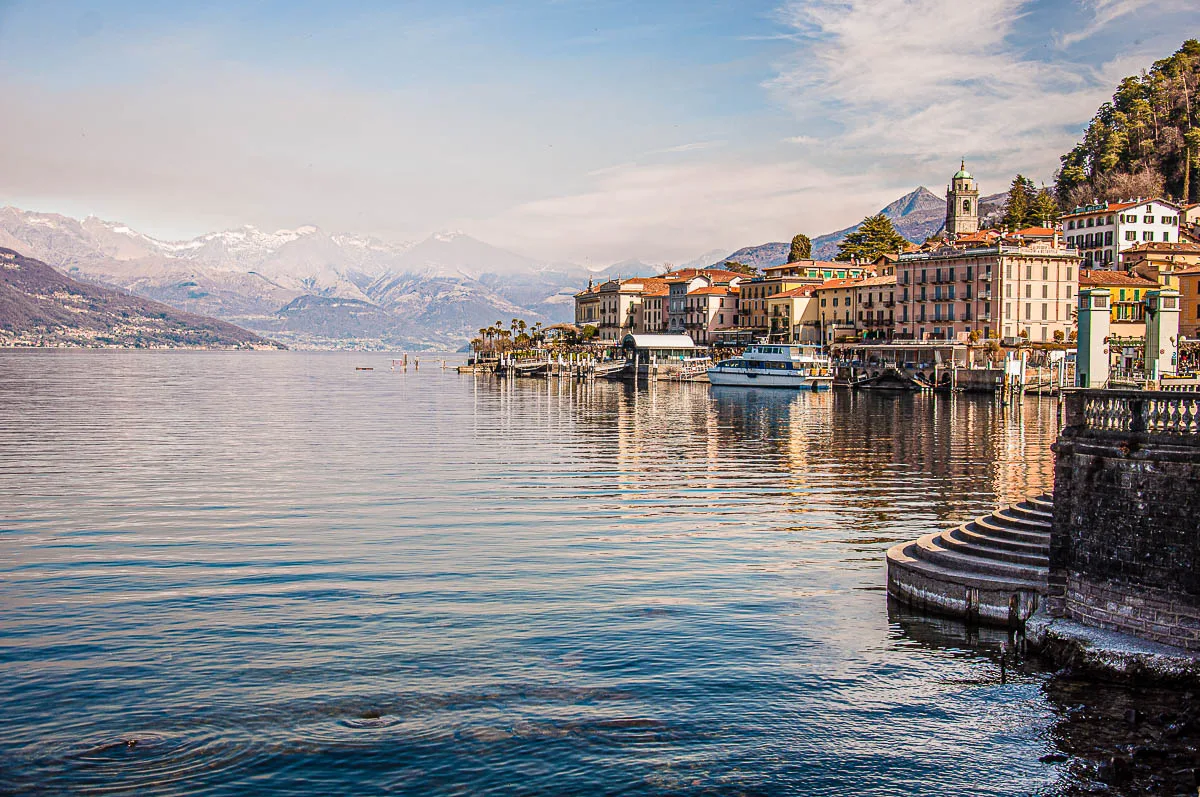
Bellagio is without a doubt Lake Como’s internationally most famous destination. This elegant town enjoys a prime location right at the meeting point of the lake’s three branches. Thus it affords splendid views towards the Alps as well as down the Como branch and the Lecco branch of the lake.
Hundreds of thousands of people visit Bellagio each year. The hubbub takes over the town’s historic streets with visitors eager to experience the best of Lake Como.
I was lucky enough to see Bellagio for the first time on a bright winter day when the crowds had just started to swell again in expectation of the new high season.
Walking into the town’s historic part, the photo above captures the view that greeted me. The elegant buildings seemed to glow in the pale sun and their gem-like colours beautifully contrasted with the snow-capped Alps in the distance.
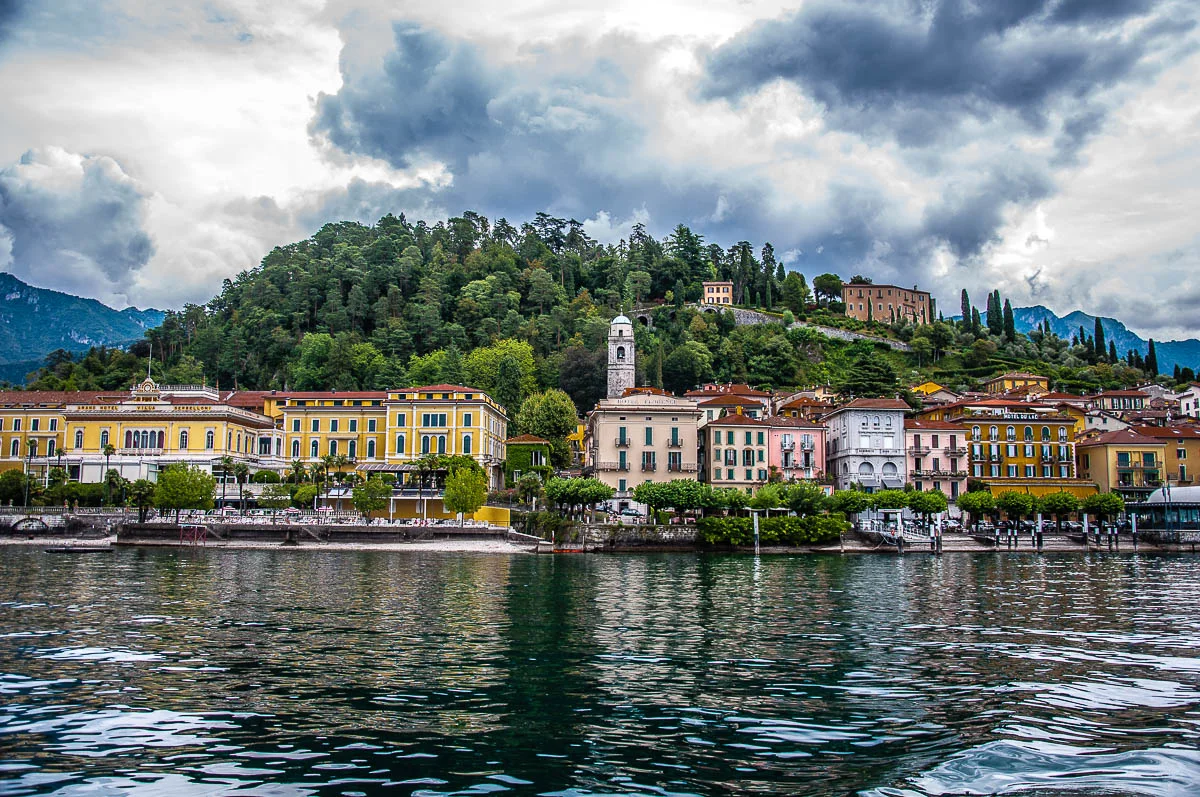
Here is Bellagio again, this time seen from the board of one of the ferries that crisscross Lake Como. Sitting on the deck and watching Bellagio slowly drifting away in the distance is a very cinematic experience.
The dark water, the gem-coloured buildings, and the small lush hill are picture-perfect with that rare type of beauty that is created in equal portions by man and nature.
They say that Bellagio is where the famous Roman author and magistrate Pliny the Younger used to have two villas. One called Tragedia and the other – Commedia. Apparently, he would split most of his time between the two.
Tragedia was on a small elevation above the lake. Commedia was right on the water so that Pliny the Younger could easily fish from his bedroom. Although the exact locations of the two ancient villas are unknown, it’s easy to understand why many think that both Tragedia and Commedia were where the town of Bellagio stands nowadays.
The setting is perfect plus it provides splendid views and the Ancient Romans were true masters at picking the best locations for their villas.
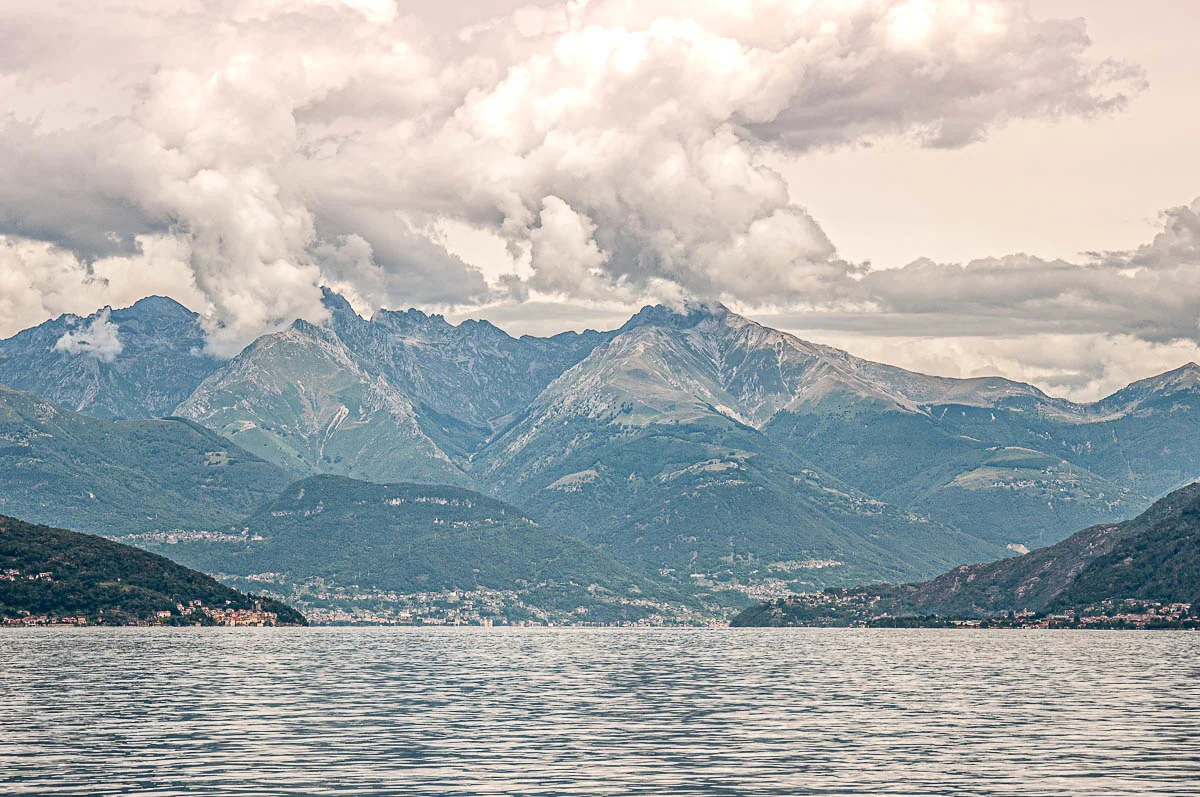
This is the view that greets you when you stand right at the spot in Bellagio where Lake Como’s three branches flow one into another. The Alps look regal on the horizon and a myriad of small towns dot the lake shores.
Here, you can just about make the town of Menaggio on the left-hand side and the town of Varenna on the right-hand side of the photo.
A ferry line regularly connects these two towns and Bellagio, thus forming a triangle at the meeting point of the lake’s three branches. You can jump on a ferry and visit the three towns in one day or take it easy and dedicate a day to each.
I think, a big part of the charm of Lake Como is how unhurried you feel here. How the aim is not to tick off as many sights as you can but to experience the relaxed rhythm of the lake and its towns. To sit at an outside table for a light lunch or a coffee and dessert and just see who is going to walk past, how the leaves of the large palm trees sway in the gentle breeze, and how the clouds move above the mountain tops.
Sometimes, we experience the most by being still. And Lake Como is the perfect setting for this. Provided, of course, you avoid the truly busy days of the high season.
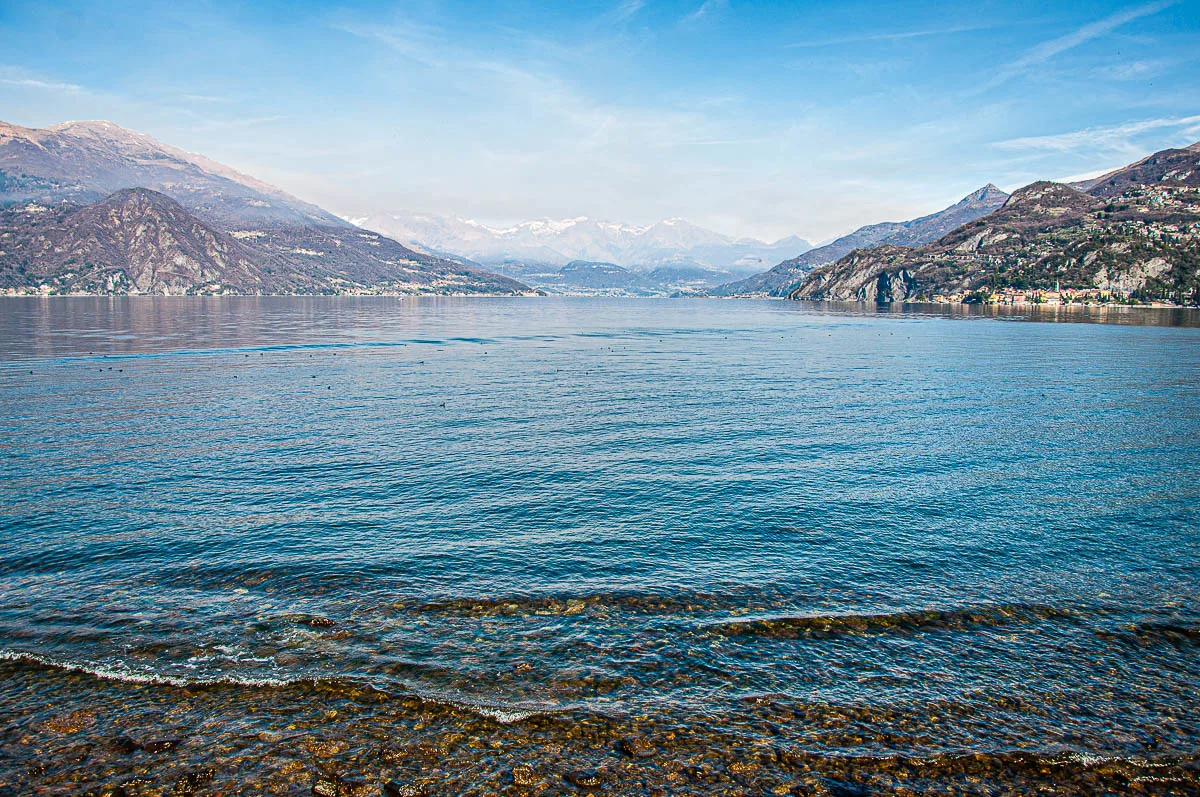
It is by returning to the same spot at different moments and by sitting still while there, that we can truly see how it changes.
This is the same place as in the preceding photo above – the spot in Bellagio where Lake Como’s three branches meet. Yet, it looks so different. The water is blue and the snow-capped Alps look smaller and unthreatening on the horizon.
Nature reveals its many faces to us as long as we put a bit of time aside to observe it. It’s the most satisfying TV show of all times. One where you actually feel connected to, an intrinsic part of what is happening in front of you. Instead of a passive spectator, you become an active observer. You just need to lift your head, step back or forth, move your eyes left or right and the whole perspective changes.
Lake Como gives you so many opportunities for such quiet contemplations.
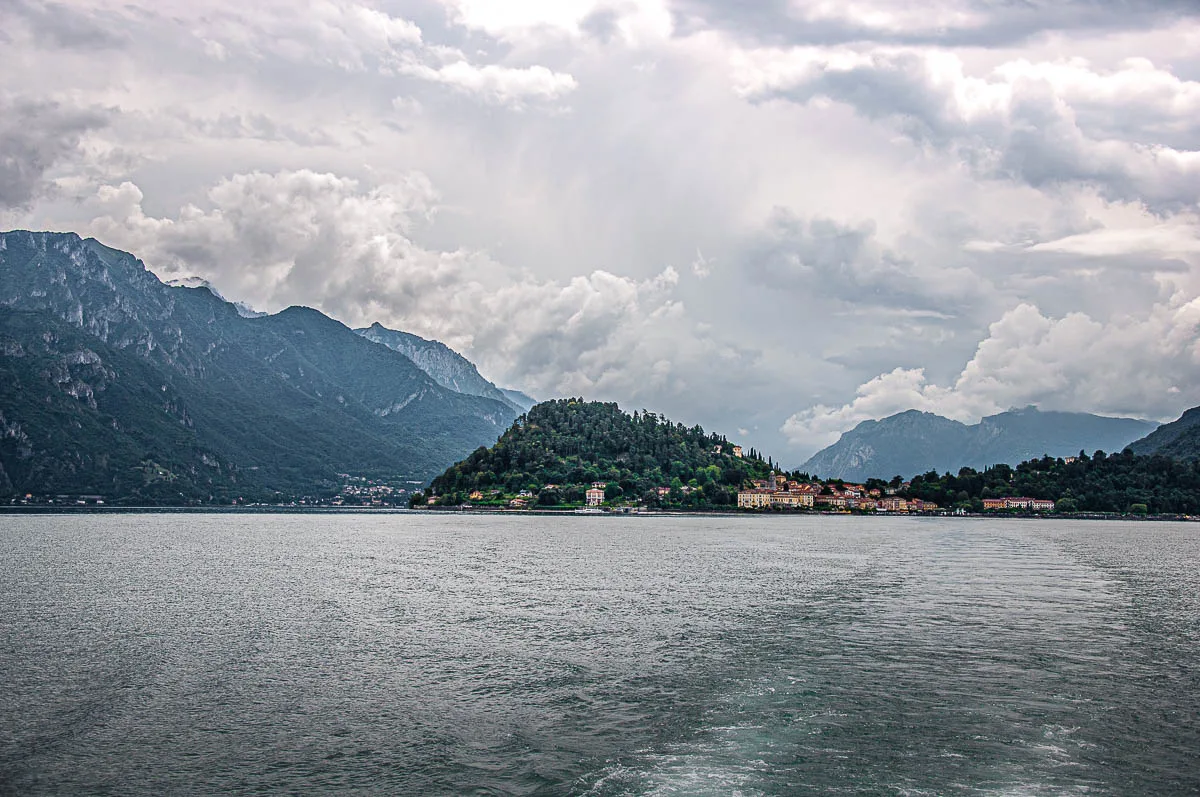
One last look at Bellagio from afar.
Here you can clearly see the tip of the peninsula which cuts the bottom half of Lake Como in two branches. With Bellagio’s historic part concentrated in the tip’s gentle curve, the peninsula then rises one last time into a nicely rotund hill before disappearing into the lake’s waters.
On the left-hand side of the photo, where the water seems to end in a clear-cut line against the shore, this actually is the start of the Lecco branch of Lake Como.
On the right-hand side, you can see the beginning of the lake’s Como branch. And then the clouds provide the perfect frame for this spectacle of nature.
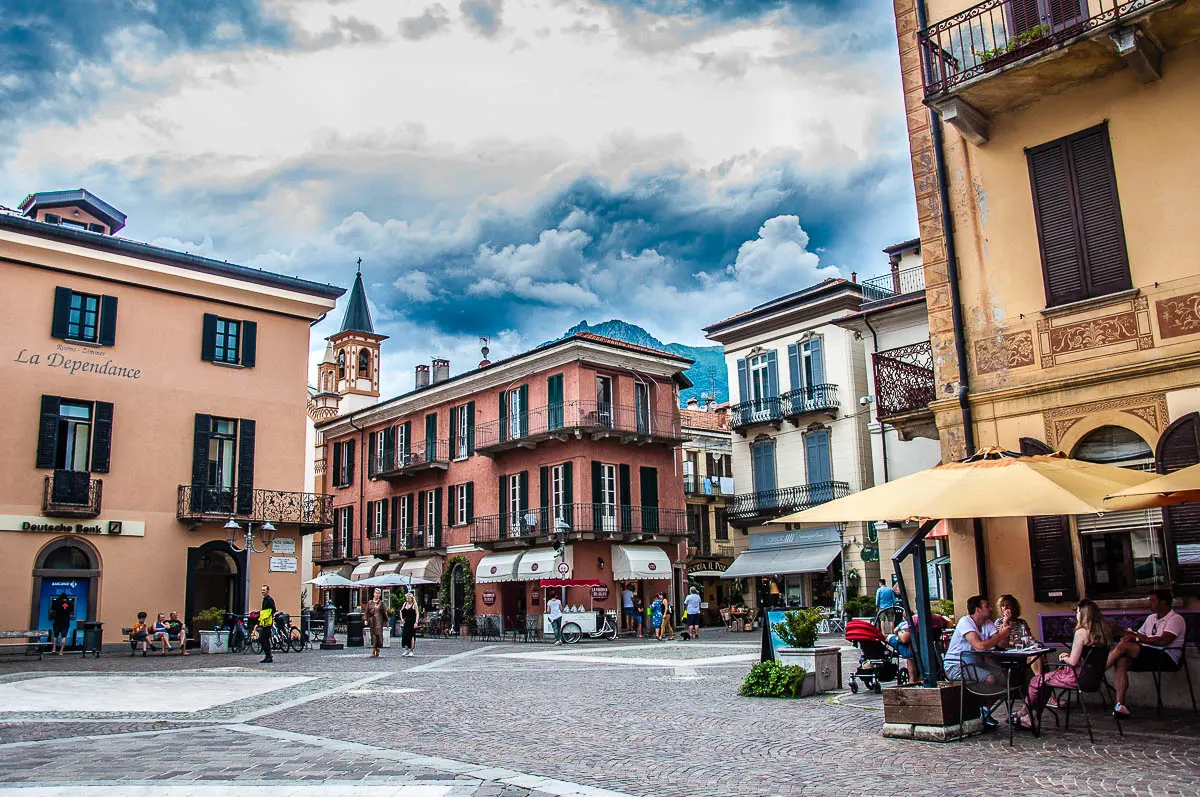
And here we are in Menaggio – a small lakeside town just across the water from Bellagio.
A powerful summer storm is about the unleash its anger over the town. But in the minutes before it hits, all is peaceful and quiet. People talk with friends over lunch, tuck into a delicious portion of gelato, walk up and down the cobbled square.
Just the sudden gust of wind reveals what is about to happen. Serviettes fly off tables, large umbrellas flap desperately in the wind, waiters start rushing around, moving plates and patrons that a minute ago have been sitting in the sun outside to the dim inside rooms of the taverns and restaurants.
We tuck quickly into our meals. Are we going to make it back to the car before the rain starts in earnest? The wind is whipping palms and buildings outside.
We pay the bill and start running back to the car park. The rain catches up with us just as we are opening the car doors. Huge fat raindrops quickly hide everything around us. They splash against the windshield and the wipers almost can’t keep up. We drive slowly and carefully towards the ferry port. The colourful buildings of Menaggio look like watercolour splashes behind the wet car windows.
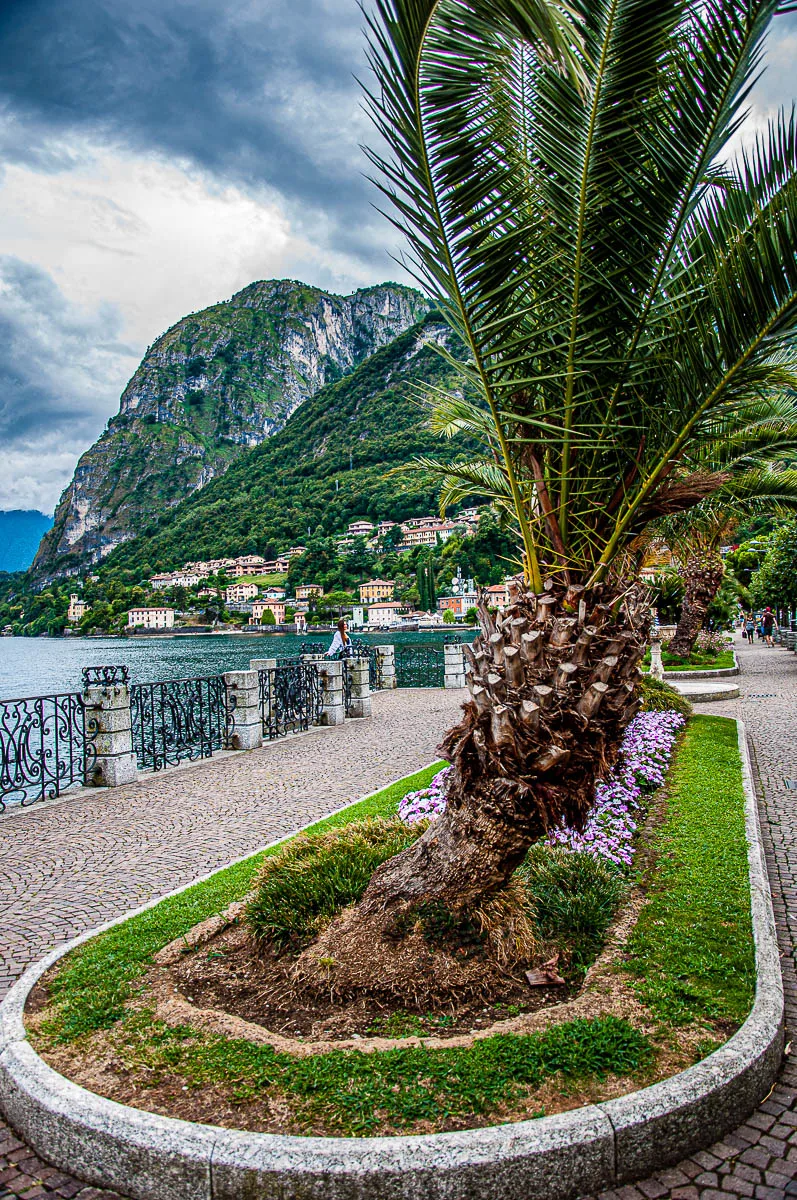
Just a couple of hours before the storm started, we walked – happy and carefree – along Menaggio’s pretty promenade. Lined up with flowers and trees, it opened splendid lakeside views. The tall mountains with their green capes provided the dramatic backdrop.
It was the start of August – traditionally, the highest point of the high season. Yet, after the strict lockdown that had kept all of Italy inside for months in the first half of 2020, we found Menaggio free of tourist crowds. The town felt beautiful and peaceful. That’s it until the storm hit but rushing up Menaggio’s streets, trying to outrun the rain made for a great memory.
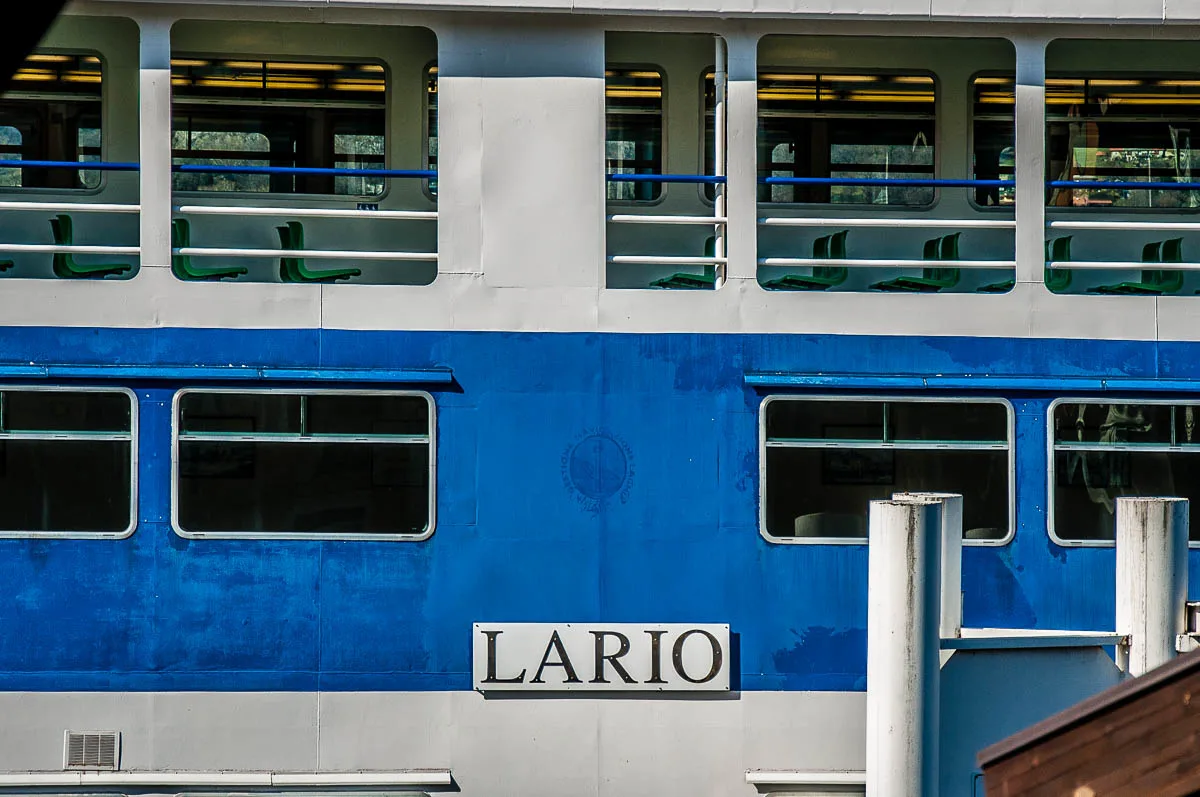
The ferry! At last!
Time to cross over to Varenna – another charming town on the shores of Lake Como.
Or should I say Lake Lario instead?
Initially called Lacus Larius, nowadays the lake is universally known under the name of Como from the largest town on the lake shores. Yet, there are those who continue the tradition and keep calling it Lario – the Italianised version of the lake’s original name.
What is the etymology of Larius? There are two versions. One is that the toponym precedes the arrival of the Romans and is based on the pre-Indo-European root ‘lar’ meaning ‘hollow place’. The other is that the lake owed its name to the introduction by the Romans of the laurel plant (in Latin, laurus) along its shores.
As a linguist myself, the latter sounds a bit off to me, as had it come from ‘laurus’, then the toponym is more likely to have kept the root ‘laur’ or simplified it to ‘lor’.
No such thoughts are actually playing on my mind as the ferry crosses Lake Como on its way to Varenna. I am too busy marvelling at the colourful little town that reveals itself through the curtain of rain.
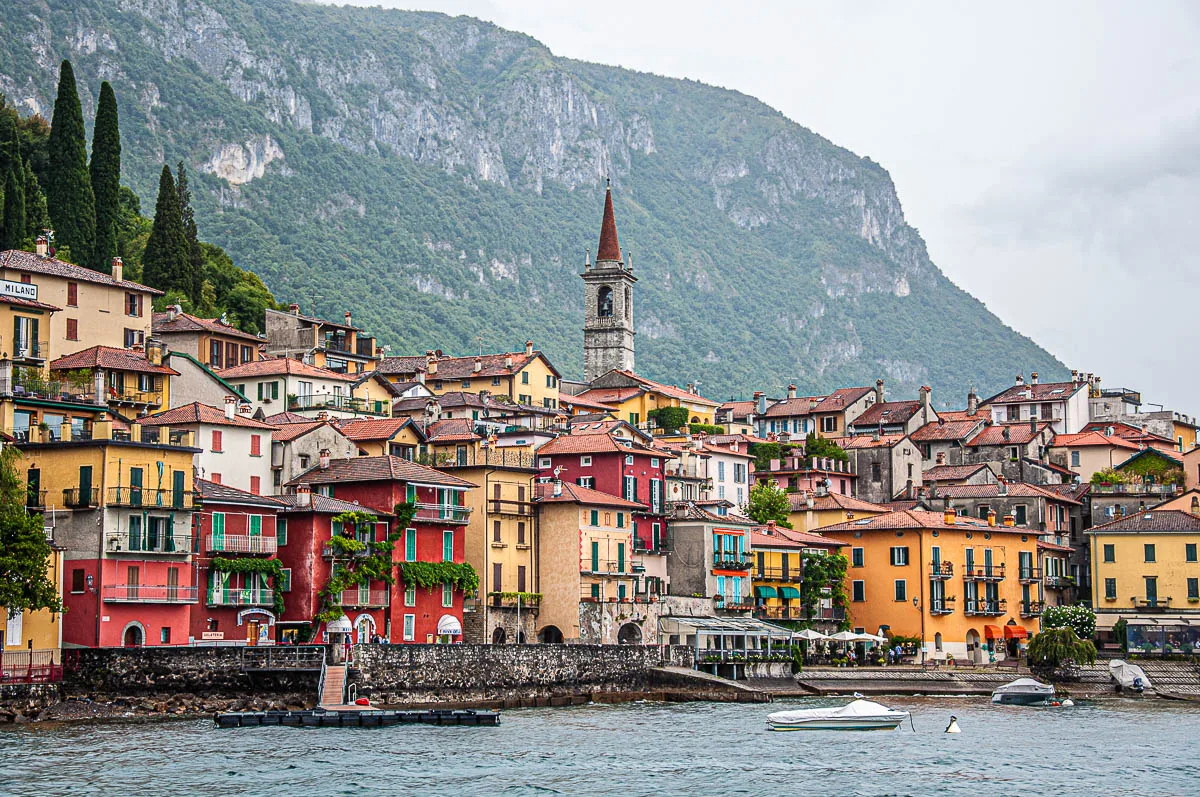
Varenna is so pretty, isn’t it?!
Originally a medieval fishing village settled in an area that had been inhabited since the Bronze Age, nowadays Varenna is a beautiful lakeside town where colourful houses make you swoon with thoughts and dreams along the lines of: ‘Gosh! I wish I could live here!’
Directly connected to Milan by train, Varenna is one of the easiest to reach towns on Lake Como. Yet, it has the charm of a place that is still almost undiscovered by the masses. Most people that reach Varenna head to its lavish Villa Monastero. With its terraced botanic garden, it affords some of the most iconic views of Lake Como.
Walking around the grid-like streets of Varenna is a very pleasant experience. With their innate sense of beauty, the Italians love using plants and planters to decorate facades, walls, and gardens. This makes the whole town look like a garden.
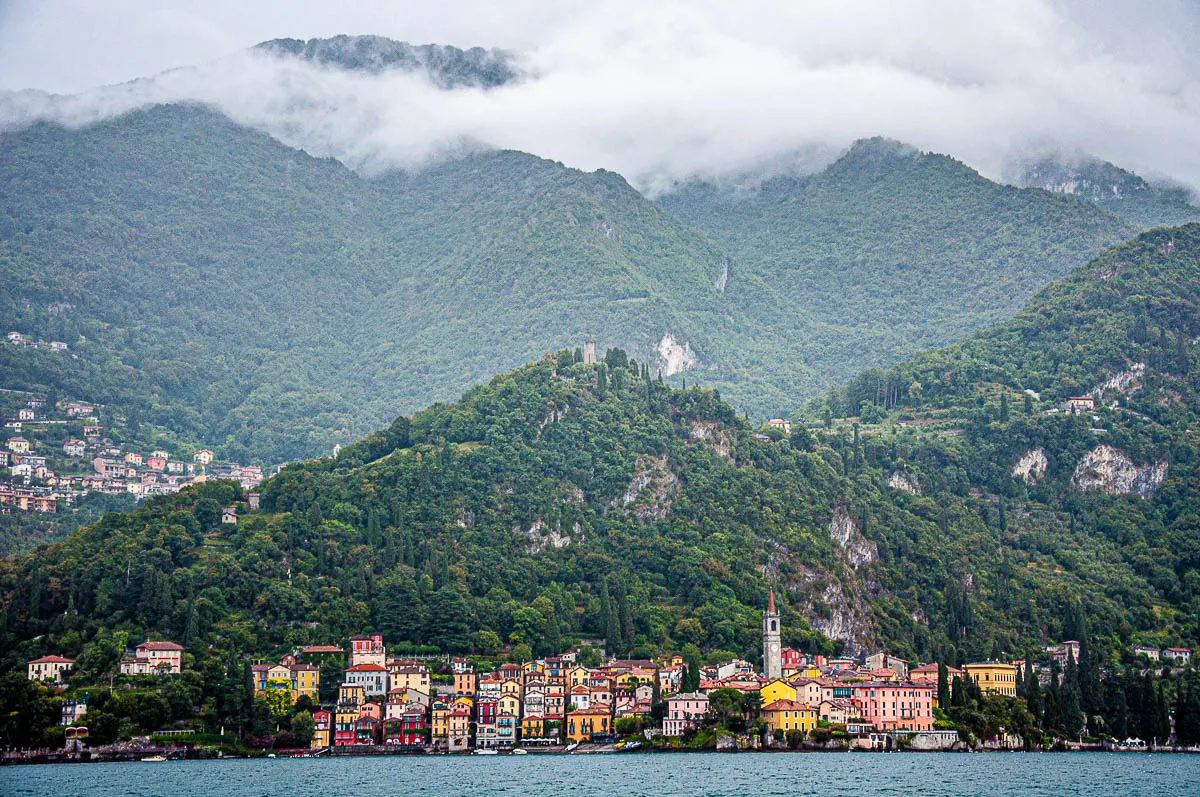
Varenna is huddled at the bottom of a steep hill crowned by the Vezio Castle. Over a thousand years old, it was built by the Lombard Queen Theodelinda as a defensive military outpost. You can spot the castle in the photo above. It’s just on the triangular top of the lush hill backed by the cloud-enveloped mountains.
In the past, a strong defensive wall started from the castle and ran down on both sides of the hill all the way to the lake’s waters, thus holding in a tight embrace the town of Varenna.
While the wall is long gone now, the castle’s sturdy rectangular tower survives to this day. Inside it, you can see Lake Como’s most famous pre-historic inhabitant – the Lariosaurus. It sounds quite scary, doesn’t it?! But this long-extinguished marine reptile would grow only up to about a meter.
Several Lariosaurus fossils were uncovered in 1830 just a few hundreds of meters away from the Vezio Castle. Their story is traced in the museum exhibition inside the castle.
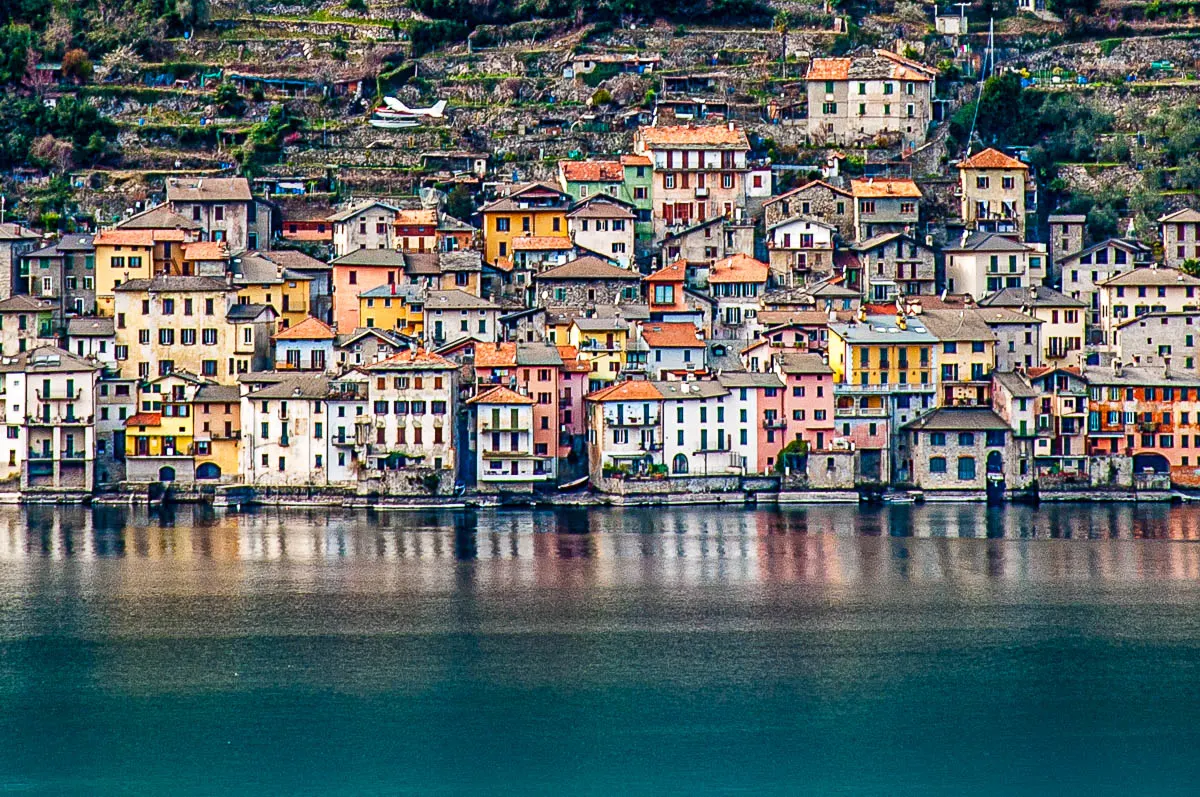
Looking at Lake Como’s dark waters, it’s only too easy to imagine them haunted by a pre-historic monster. After all, this is the fifth deepest lake in Europe and the deepest outside of Norway! Straight down, you have more than 400 m of water before you hit rock bottom.
During my time at the lake, I became a bit obsessive about capturing this stunning contrast between the dark waters and the colourful houses of the small lakeside towns.
This is the town of Brienno, for example. If you look at the left-hand side of the above photo, you will see a small seaplane just above the rooftops. I would be sitting in our hotel room in the town of Nesso or in the garden of our friends that live there, look across the lake to Brienno and photograph it perhaps hundreds of times, never capturing quite well the stunning contrast between waters, houses, and mountains.
Above us, small seaplanes would zip back and forth, taking tourists on a flight of a lifetime above Lake Como.
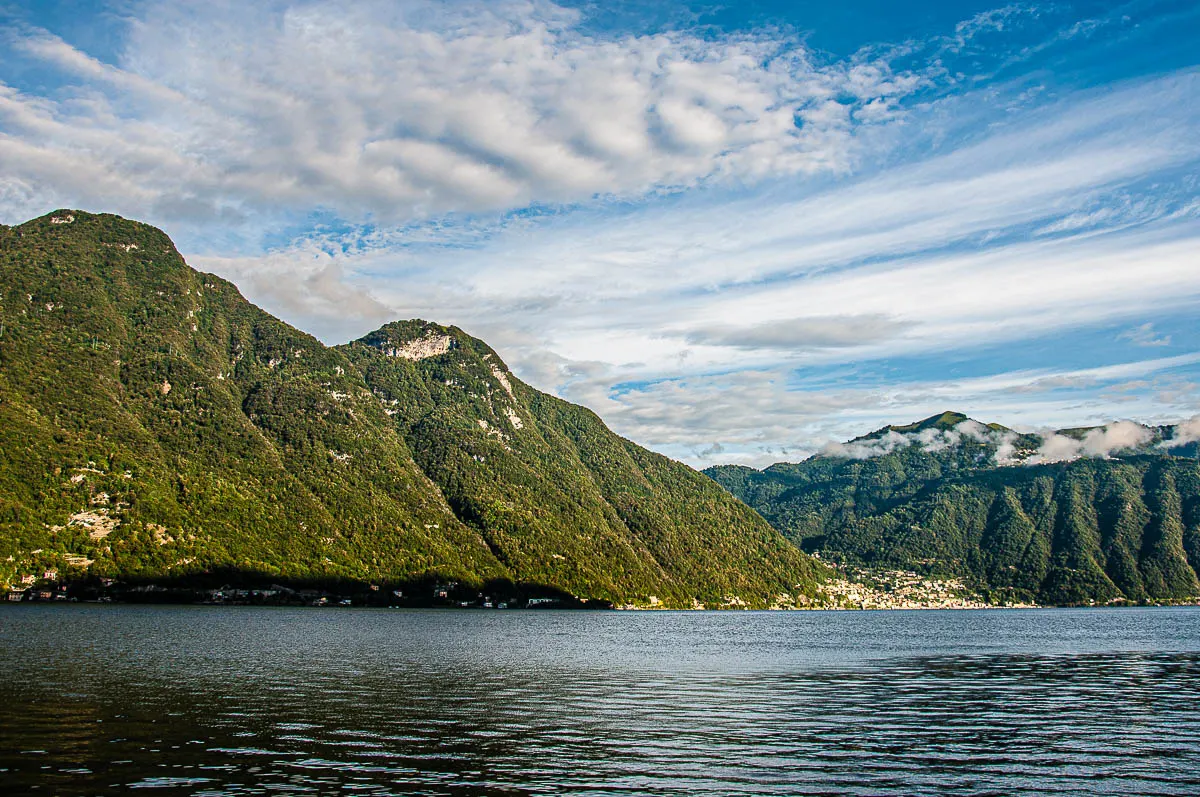
Here is another of the many photos I took from Nesso – a small town on the lake’s Como branch. Brienno is just out of view on the left-hand side of the image.
It’s early morning and I had walked by myself down to the water edge. Light fluffy clouds were lifting themselves up off the hilltops after a night of sweet dreams.
The sky was the perfect shade of blue and the water dark as always. I could see a small village right under the summit of one of the tall hills, waking up still half-covered by the blanket of the clouds.
I wondered how difficult it must have been in the past centuries to reach such small villages around Lake Como. Would they remain isolated for most of the year and what life must be like up there looking at the lake all day long but never quite able to easily reach it.
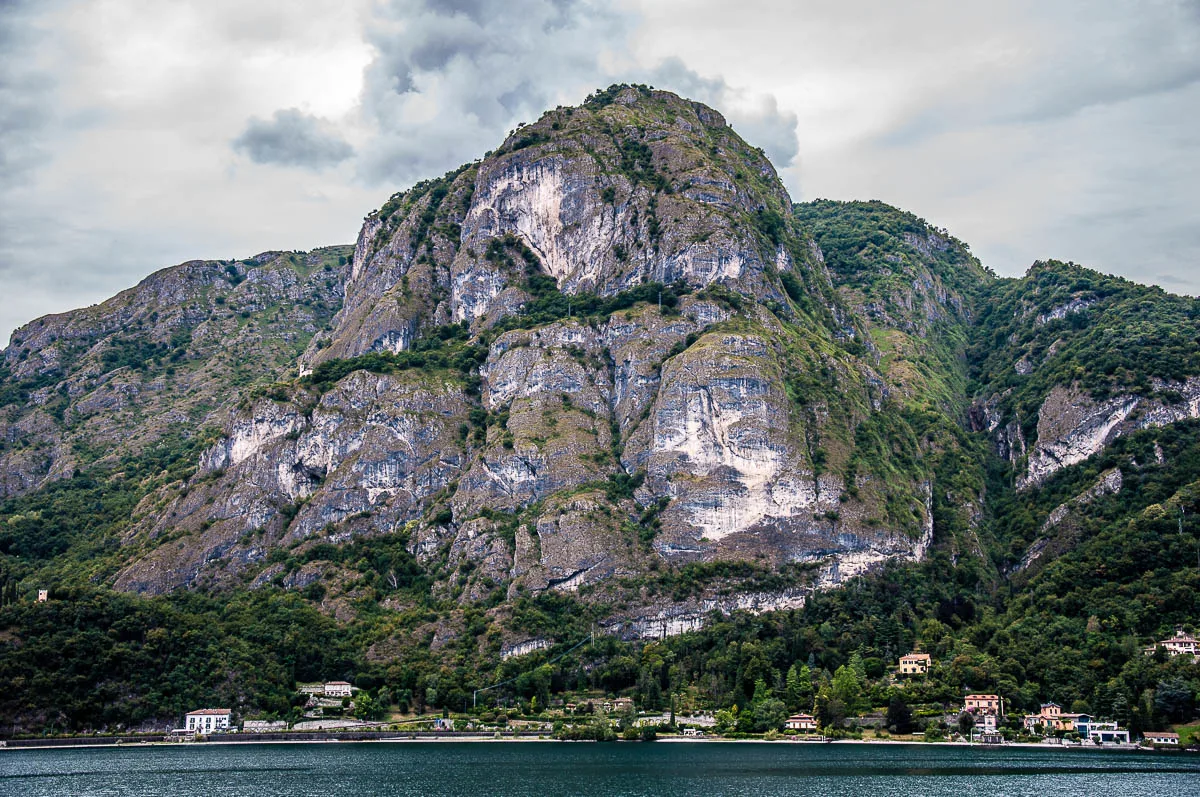
Here is another one of those seemingly inaccessible spots around Italy’s Lake Como.
If you look very, very carefully at the above photo, on the left-hand side and about two-thirds up the steep cliff, you will notice a tiny, tiny church. This is the Sanctuary of the Madonna delle Grazie di San Martino. It’s above the small town of Griante which is just across the water from the promontory of the town of Bellagio.
People hike to the small church to revel in the stunning panoramic views of Lake Como.
What I am more interested in is the devotion that makes you erect a church at such a high spot. Not having been brought up as religious, I am always amazed by the strength of faith and how it seems to conquer the most insurmountable of places.
In my time at Lake Como – short as it was – I came across several such small churches and places of devotion which must have taken an extraordinary effort to build and maintain considering the steep slopes surrounding the lake.
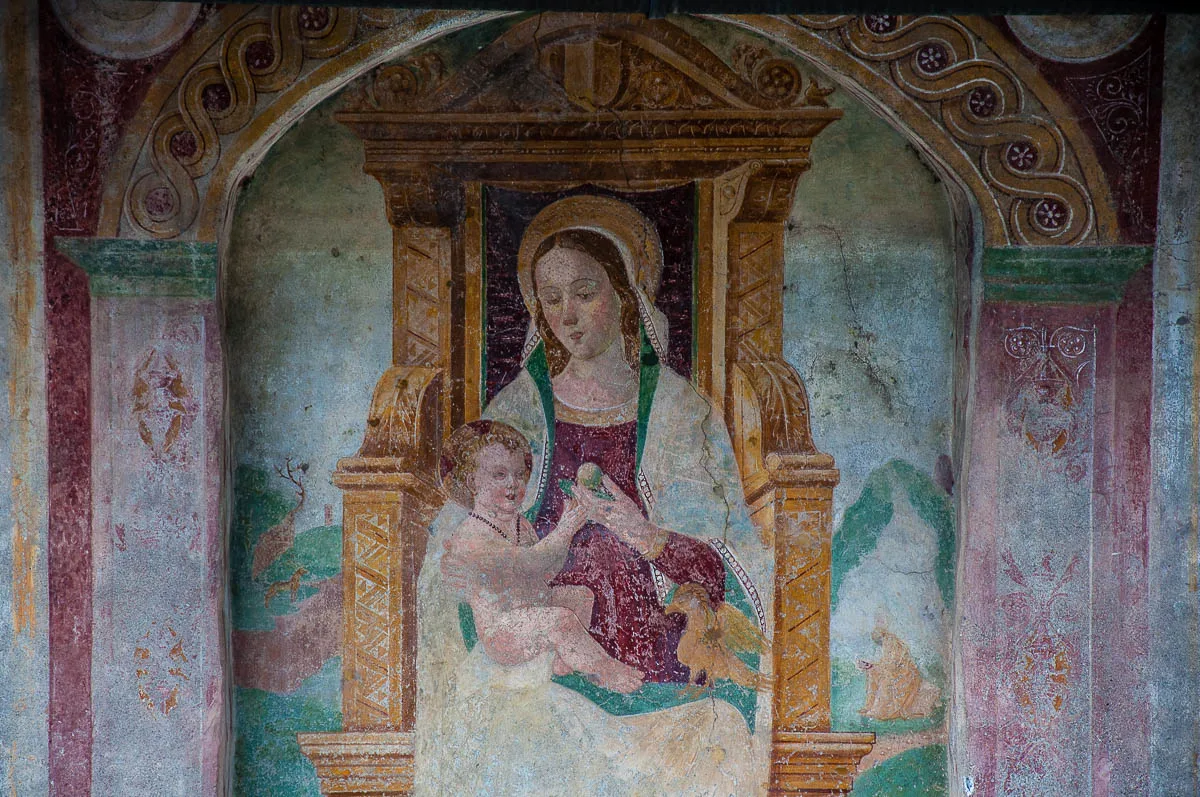
I remember spending a long moment looking at this fresco on the outside wall of the small medieval Church of Santa Maria di Vico in the town of Nesso.
It was painted by Bartolomeo de Benzi – a little-known Lombardian painter active at the end of the 15th and the first years of the 16th centuries. The fresco – somewhat protected by an overhanging eave – has spent many decades exposed to the whims of the weather.
It’s faded, peeling off, some portions are completely obliterated. Yet, I am captivated by the Madonna’s face. It’s full of motherly tenderness and yet she seems lost in thought. She gives Baby Jesus a fig and a strange bird is perched on her knee.
I try to decipher in the faded landscape behind the Madonna’s lavish throne some unmistakable features of Lake Como’s panorama. I see a medieval tower, a large tree, an animal that is perhaps a dog, tall hills, and the figure of a beggar. The colours and shapes are pale and difficult to read.
Beyond the small humble church lies Lake Como in all its splendour. I try to imagine what it must have been to live here in the past centuries, to come to this church every Sunday to pray, to listen to the priest, and to remain part of the community.
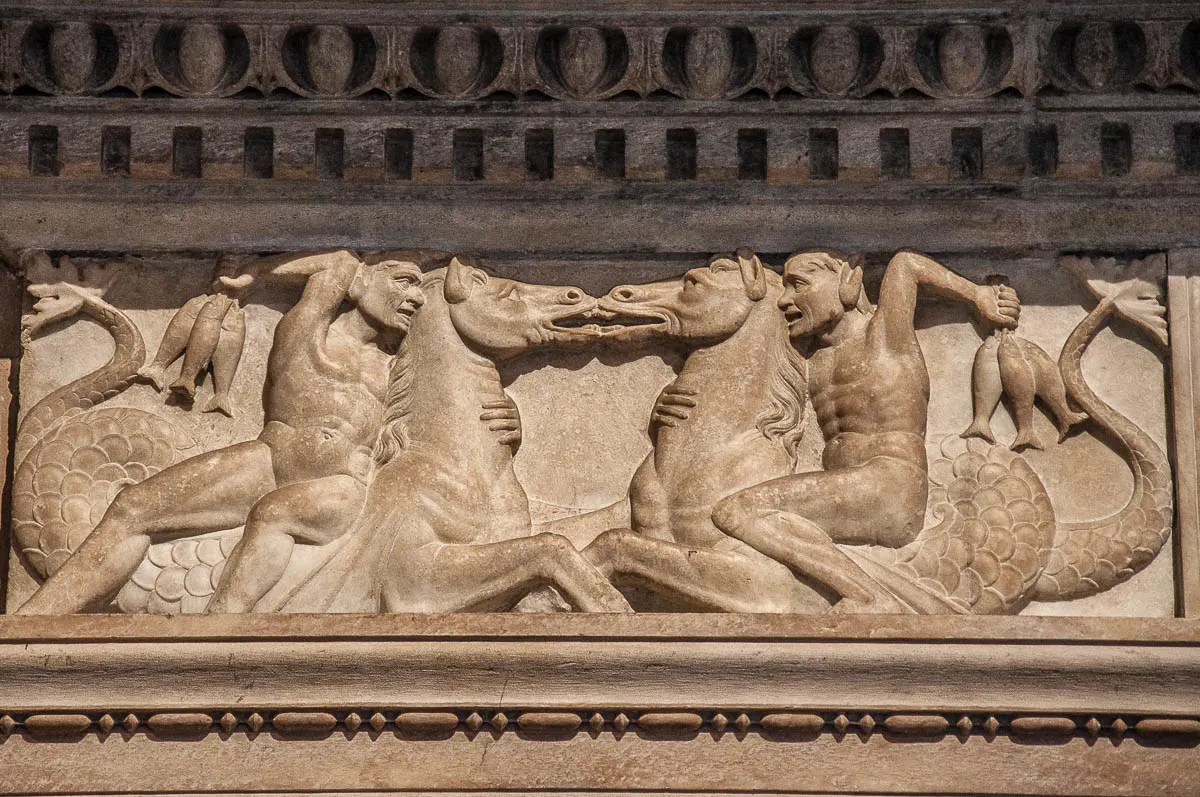
I continue my exploration of the churches around Lake Como with a visit to the Duomo di Como.
Officially known as the Cathedral of Santa Maria Assunta, this is the main church of the town of Como. You will find it in the town’s historic walled centre and it is famous as the third largest religious building in the Northern Italian region of Lombardy. It’s preceded only by Milan’s Duomo and the monastery of Certosa di Pavia.
The Duomo is lavishly decorated inside. Among the many tapestries and paintings, my eyes are immediately drawn to a bas-relief with motifs that seem inspired by Lake Como.
Winged horses with scaly tails (the mythical hippocampus) are riden by naked muscular men with elongated ears. They hold a bunch of three fish and, it seems to me, wouldn’t hesitate to use them as a club to hit each other.
I am intrigued by this mythological imagery in a Christian church. Then again, Lake Como has been a centre of human activity for millennia. Ancient tribes lived here before being supplanted by the Romans who brought Greek settlers with them. It’s only natural that some of the imagery – especially the one inspired by the lake’s proximity – would survive through the centuries and the changes of cultures on the lakeshores.
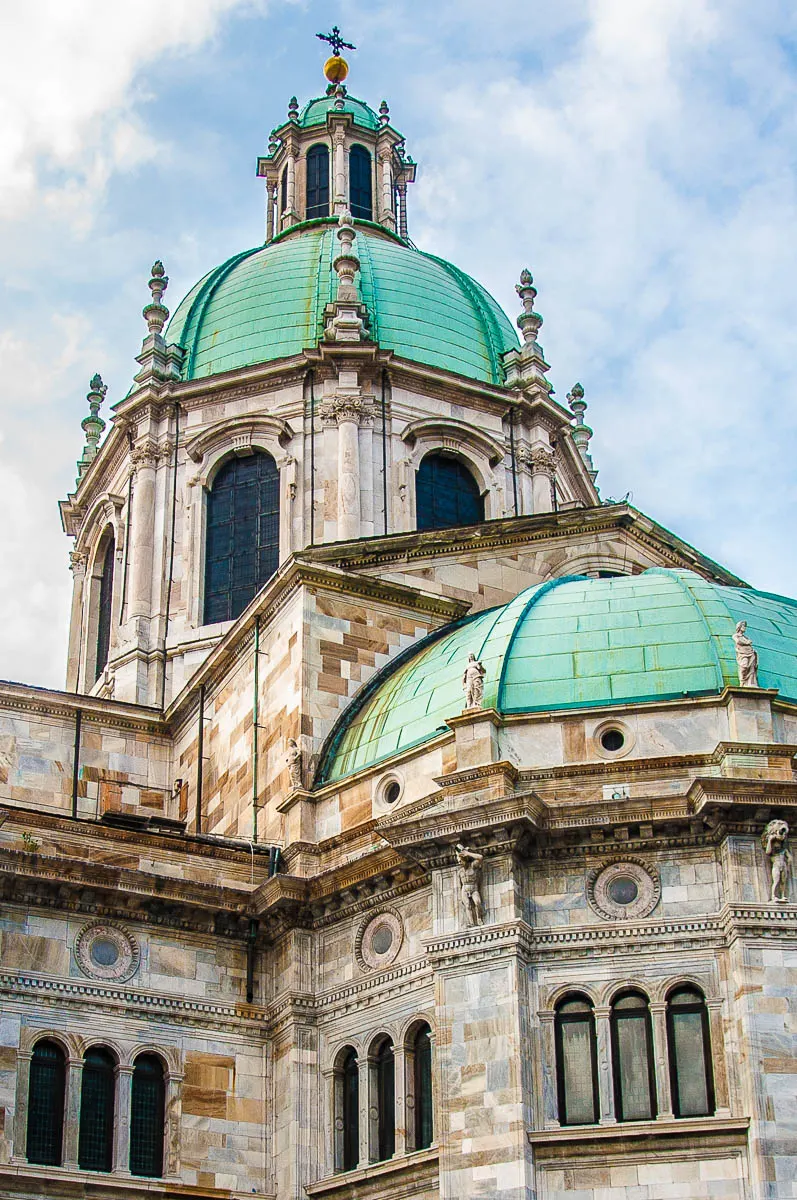
As such, two of the most famous personalities to have ever lived at Lake Como – Pliny the Elder and Pliny the Younger – nowadays are commemorated on the facade of the Duomo di Como in spite of them not actually being Christians.
The statues of the renowned Roman statesman, naturalist and author of Natural History (which is considered to be the first-ever encyclopedia) and his nephew – a lawyer, author, and magistrate of Ancient Rome – stand in niches on both sides of the main entrance of the Duomo as a testament that these two celebrated men were born in the town of Como.
It is something else that catches my eye looking at the Duomo from the outside though.
Its enormous dome is the Baroque finishing touch of the church that is Gothic in its original design and also has many Renaissance elements to it. The dome dominates the skyline of the town of Como, its green patina in gorgeous contrast to the historic centre which, otherwise, can come across as a bit grey and a bit too noisy.
They say that when visiting the Duomo, you need to stand underneath the dome and look up. You will then see the light filtering through from high above down to the altar in a visual metaphor to the descent of the Holy Spirit.
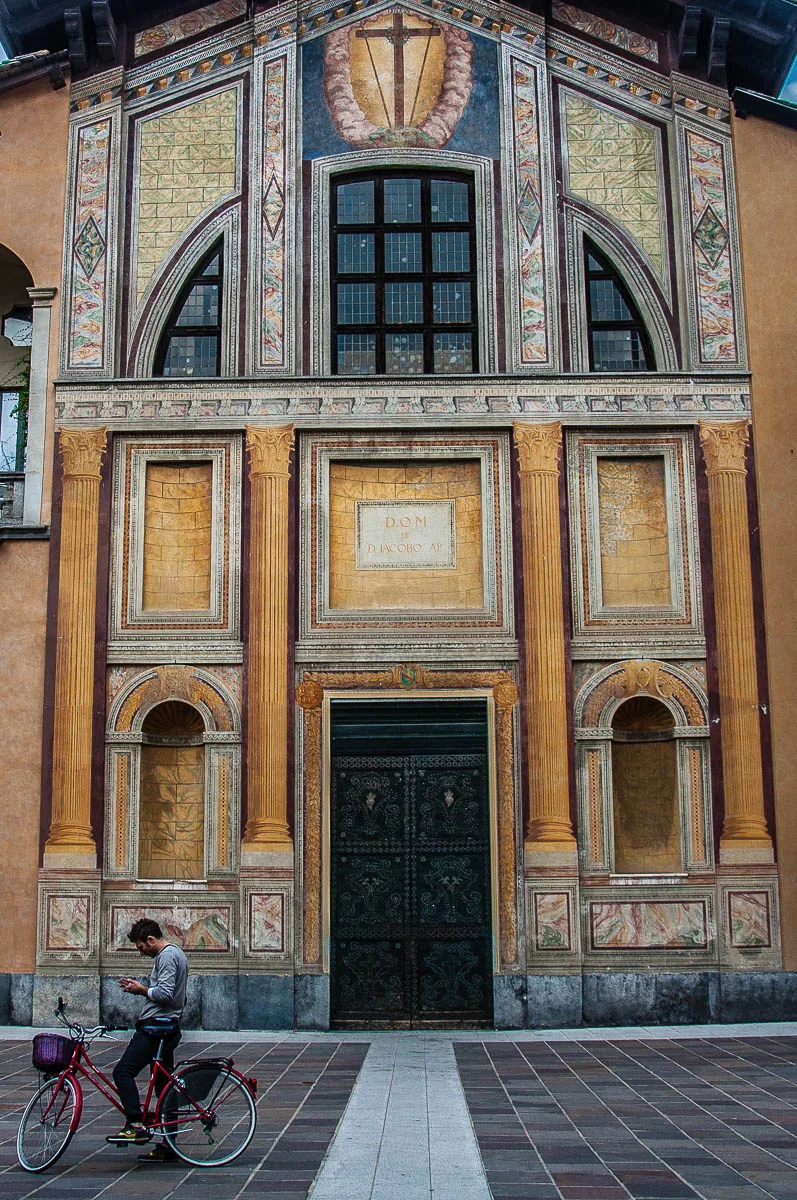
As it is typical for Italy, there are many churches dotted around the town of Como. I am particularly taken with the fully frescoed facade of the Church of San Giacomo. Almost next door to the town’s Duomo, it attracts me with its panels painted to look like precious marbles.
This style of painting dates back to Ancient Rome when ordinary people would paint the walls of their abodes with faux-marbles eager to inexpensively replicate the look of the real thing which was used in the decoration of temples and official buildings.
It was curious to see how the faux-marble style has survived through the centuries and it is still being used in spite of the change in cultures and beliefs.
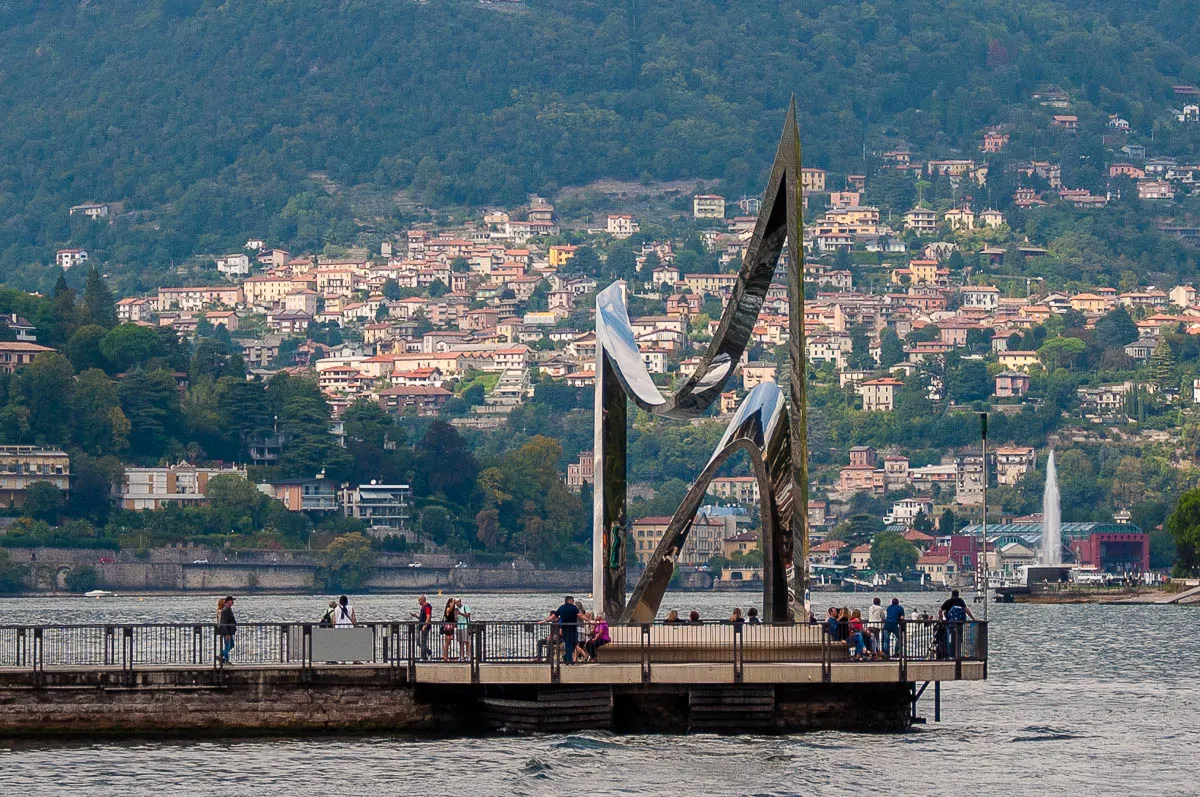
It’s not all about ancient civilisations and religious buildings around Lake Como, Italy.
Modern science owes a great deal to the town of Como for this is the birthplace of Alessandro Volta. The man who gave us the volt (V) and batteries.
To learn more about this extraordinary scientist you can go on a tour in Volta’s steps around the town of Como. It culminates with a visit to the Tempio Voltiano – a neoclassical building inspired by Rome’s Pantheon. It hosts a museum dedicated to Volta’s life and achievements.
The most visually stunning of all the Volta-related sights in Como though is the monument in the above photo. Called Life Electric, its author is the renowned architect Daniel Libeskind. Its shape replicates the electric tension existing between the two poles of a battery.
Sitting at the end of a long pier – which had to be fortified prior to the installation of the monument in 2015 – Life Electric is a focal point at the edge of the western branch of Lake Como.
People walk up to it, sit around it and look out at the lake and the surrounding shores. Water, people, trees and houses reflect in the mirror-like surface of the monument providing an ever-changing image that is quite hypnotic to observe.
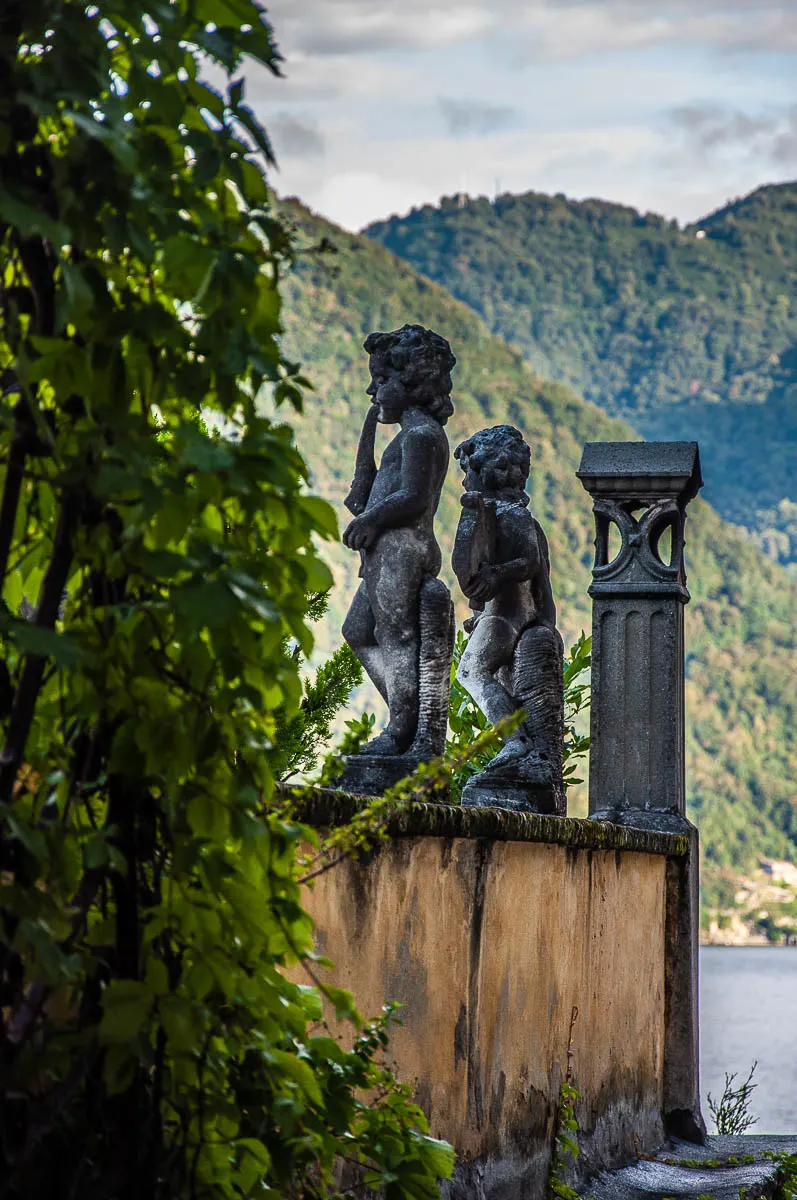
There are many other monuments and statues around Lake Como. Of course, they are not half as large or imposing as Life Electric but I love finding them with my camera to capture them against the lake waters.
Like these two small statues of young musicians that decorate the edge of a large terrace crowning a villa in the small town of Nesso.
All my three visits to Lake Como have been centred around Nesso. On account of our friends who live there.
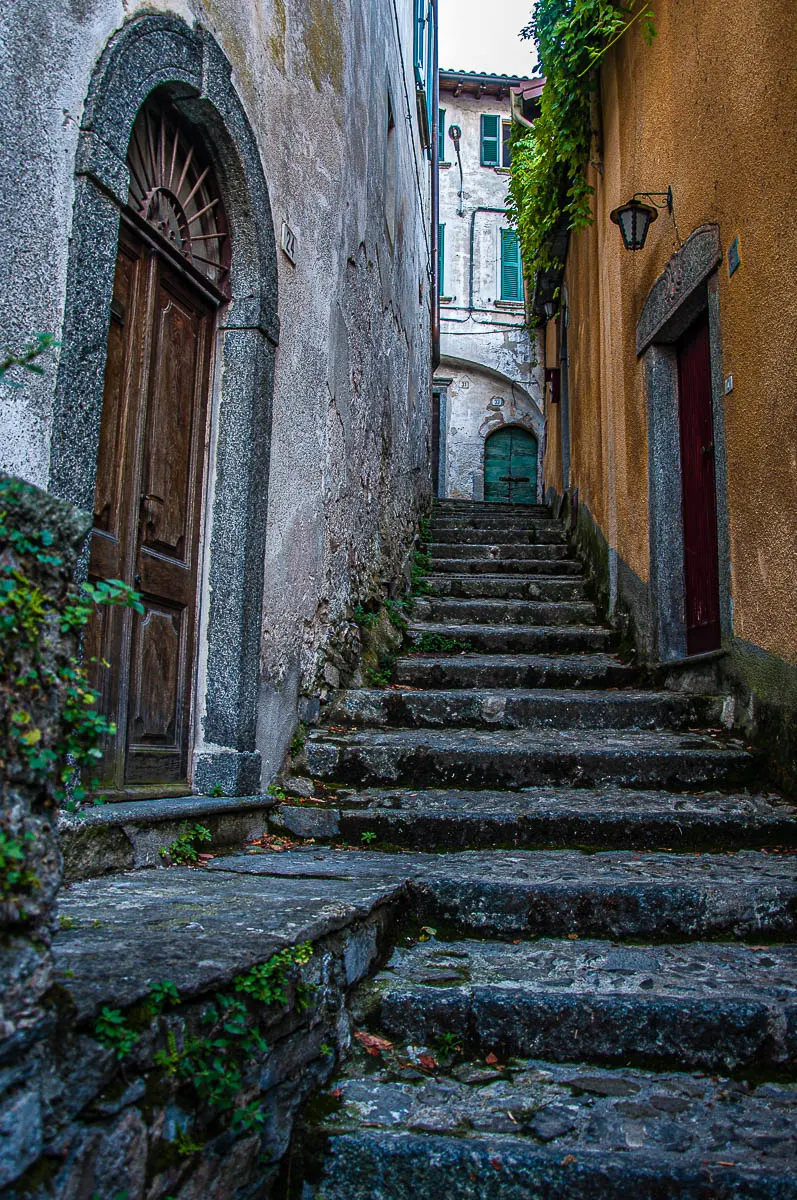
The first time that we visit our friends in Nesso, they take us for a walk down to the water’s edge.
The narrow lakeside road cuts through Nesso and then, the rest of the town’s streets seem to consist of rough steps built with jagged pebbles.
It’s a pure torture for my calves but soon I forget about it as I am too busy stopping at every step to capture life on the steep slope above Lake Como. I observe how the houses seem to cling to one another, each built at a strange angle so as to maximise the available space. I notice the stone walls draped with lush creeper plants. Huge front doors with peeling paint guard the entrances of the tall houses. Leaves, fallen last autumn, congregate in the crevices between the steps.
It’s the low season. Peace and quiet reign. In the high season, people rush down the old stone steps on their way to Nesso’s ferry port or the ancient stone Civera Bridge from which the intrepid at heart jump for fun and a swim in the waters of the lake.
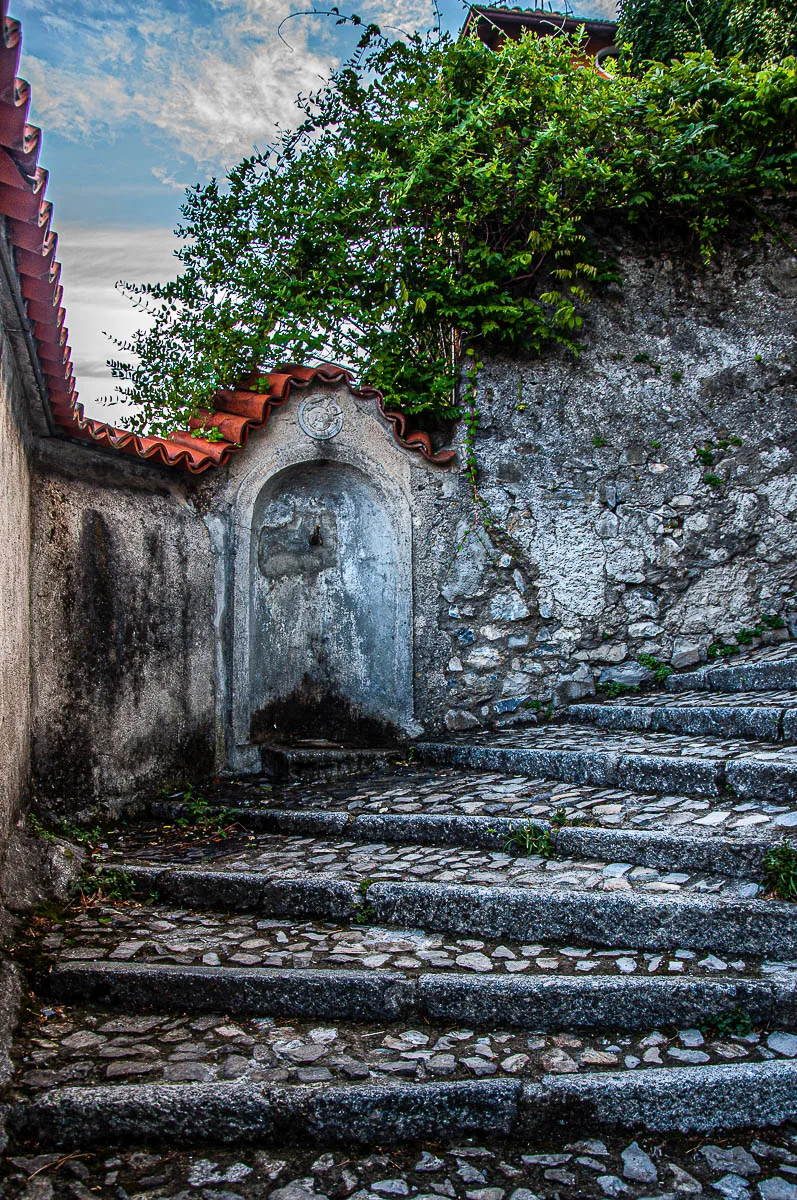
One thing I find for myself is how difficult it is to photograph Nesso. With its tall houses at strange angles, with its narrow step streets, you are constantly in and out of the sun and shadows.
Photos come either overexposed with too much light or very dark although it’s the middle of the day. I spend long moments trying to achieve the perfect balance. It’s difficult.
The others continue ahead. I lag behind for one last snap of this cute water fountain that is sitting randomly on the side of the step street just at the point where your knees feel like they are about to buckle underneath you.
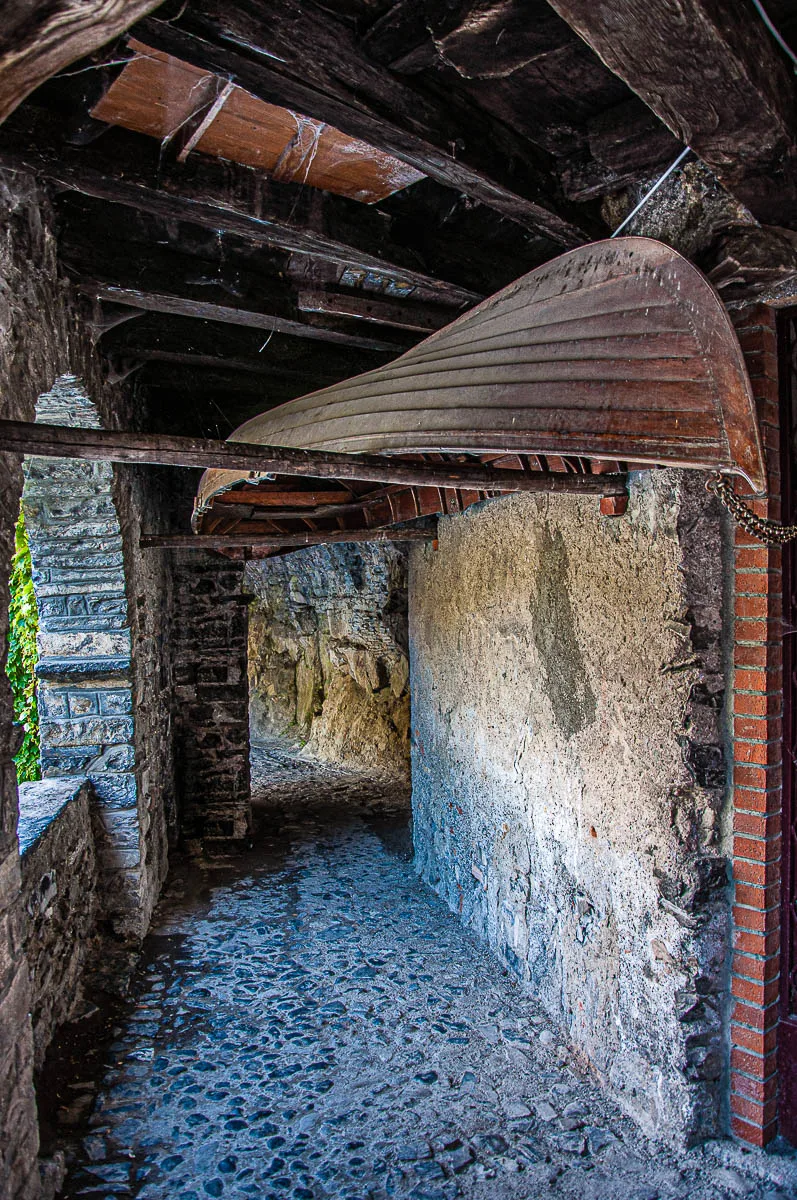
Finally, we are at the water’s edge. To reach the Civera Bridge though we need to walk first through this dark tunnel.
The tunnel is in fact, the ground floor of a large house. Inside it, the only light comes through the half-moon shaped windows that face Lake Como.
In the dim light, I spot a large boat hanging right above our heads. A heavy millstone stands reclining against the wall right next to the gateway which opens directly onto the ancient bridge.
It’s such spots that make Lake Como so whimsical and charming.
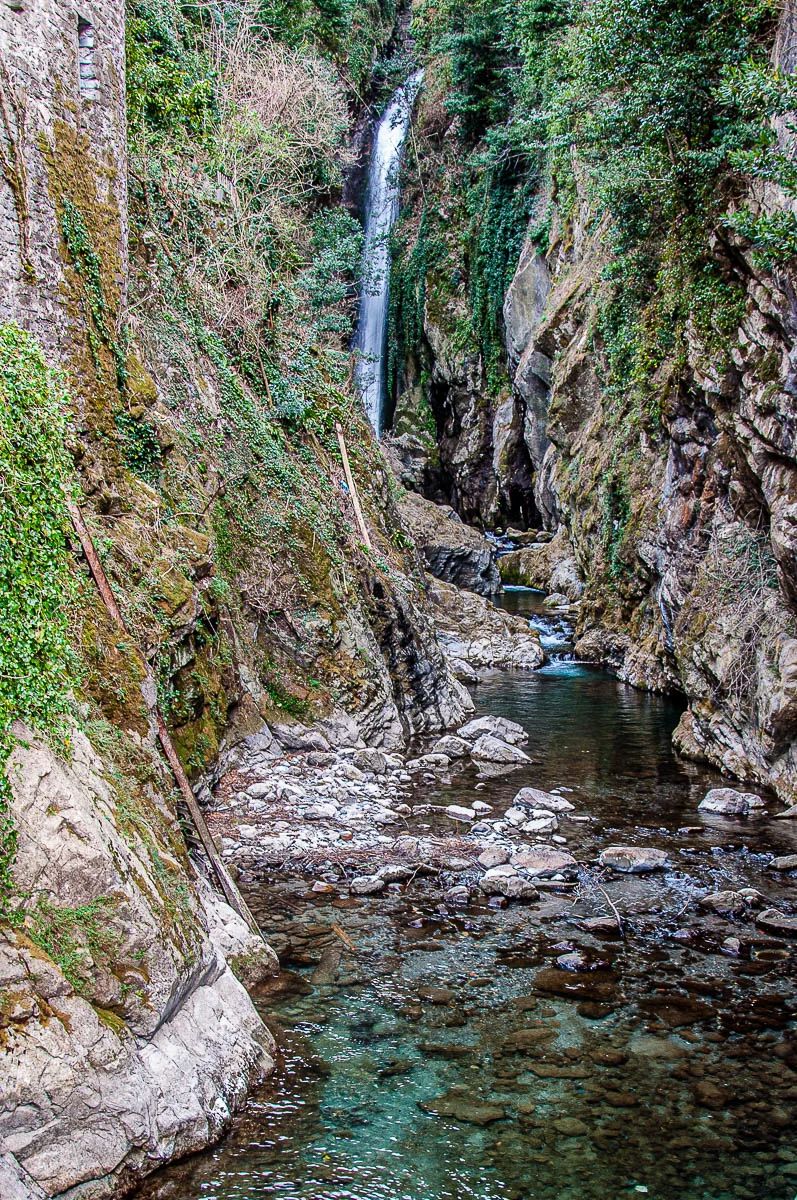
The Civera Bridge was originally erected by the Romans. It was then rebuilt during the Middle Ages on top of its Roman foundations. Its single arch spans a short creek that flows into Lake Como.
The creek is formed by the mighty waterfall that has carved the Orrido di Nesso gorge. The waterfall is the result of two streams – Tuf and Nose’ – that come together at the top of the gorge and then fall down with a rumble that can be felt all around the small town.
The point where the two streams meet is right in Nesso’s centre. Standing behind a protective metal mesh, you can see the top of the gorge and the waters flowing rapidly towards the abyss. Then you can cross the lakeside road that bridges the top of the gorge and look on the other side to see the furious waterfall beating against the vertical rocks on its way down.
From up there, the Civera Bridge looks tiny. It’s like a little arch just above the spot where the little creek fed by the waterfall flows into Lake Como.
Standing on the Civera Bridge itself, you have a front-row seat to the bottom part of the waterfall and the gorge it has created through the millennia.
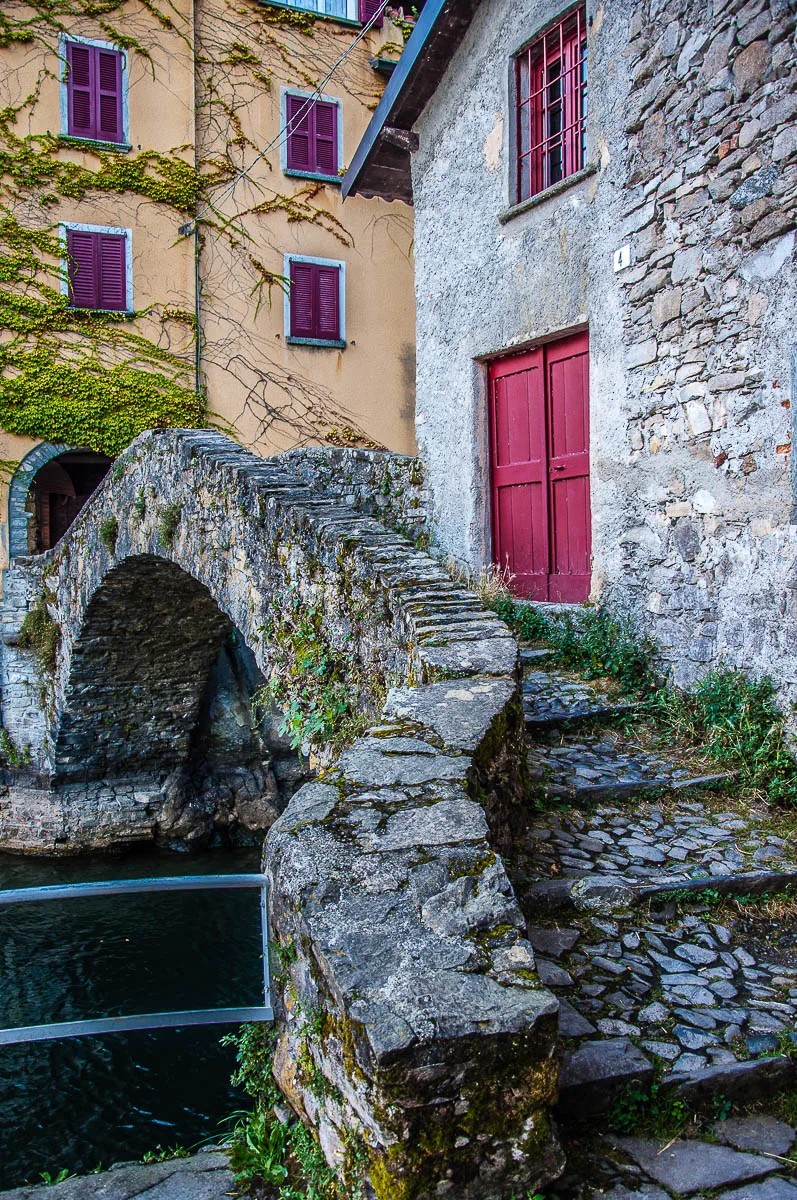
Cross the bridge and you will find yourself on a tiny terrace in front of a small old house. The waters of Lake Como sparkle in the sun in front of you and the lush green hills across the lake reach up towards the sky.
It was at this point, that the famous director Alfred Hitchcock filmed scenes in 1925 for his first film – The Pleasure Garden. If you click on this link and then watch the video from 1 min 36 secs onwards, you can see the Civera Bridge and the houses that surround it.
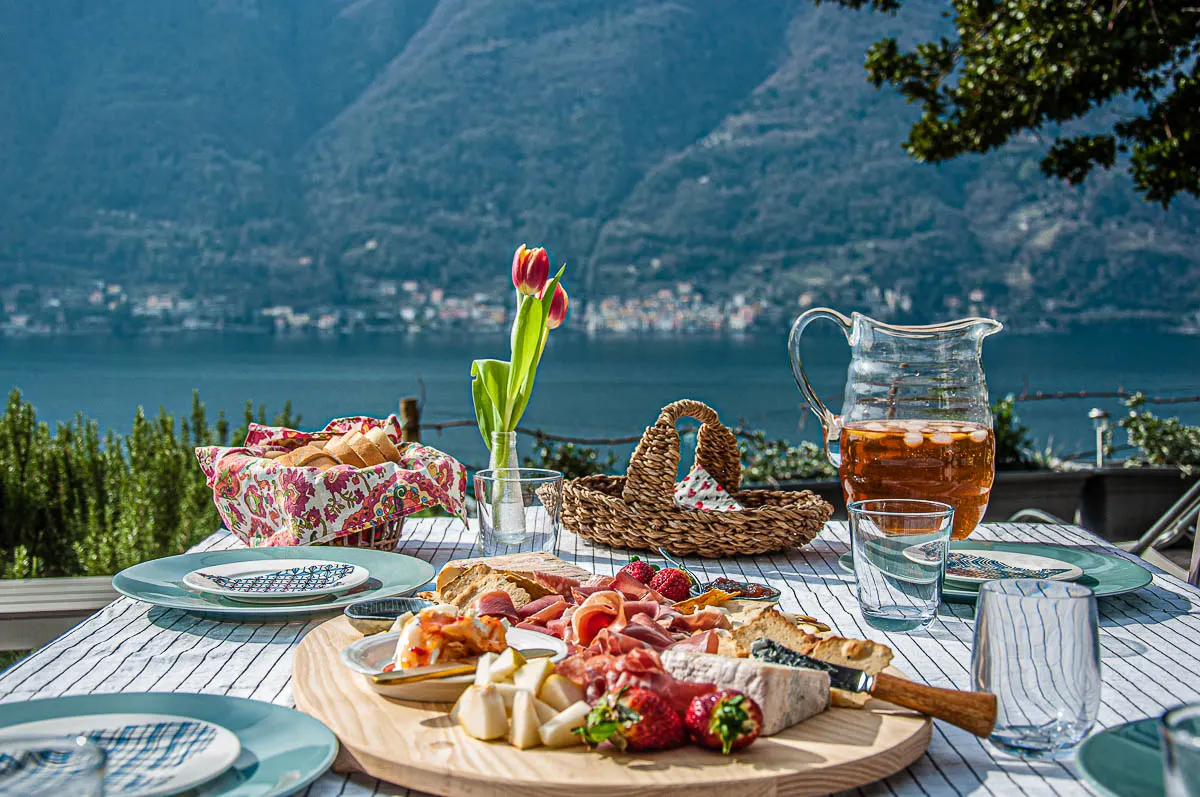
It’s time for lunch now though! Enough sightseeing!
There is nothing better than having a meal with sprawling views of Lake Como! Especially, when you are surrounded by friends.
This is the beauty of this Italian lake for me. The ability to sit down and switch off, to stop rushing around and to simply relax, to enjoy the stunning panoramic views and to engage in a happy conversation.
In Conclusion
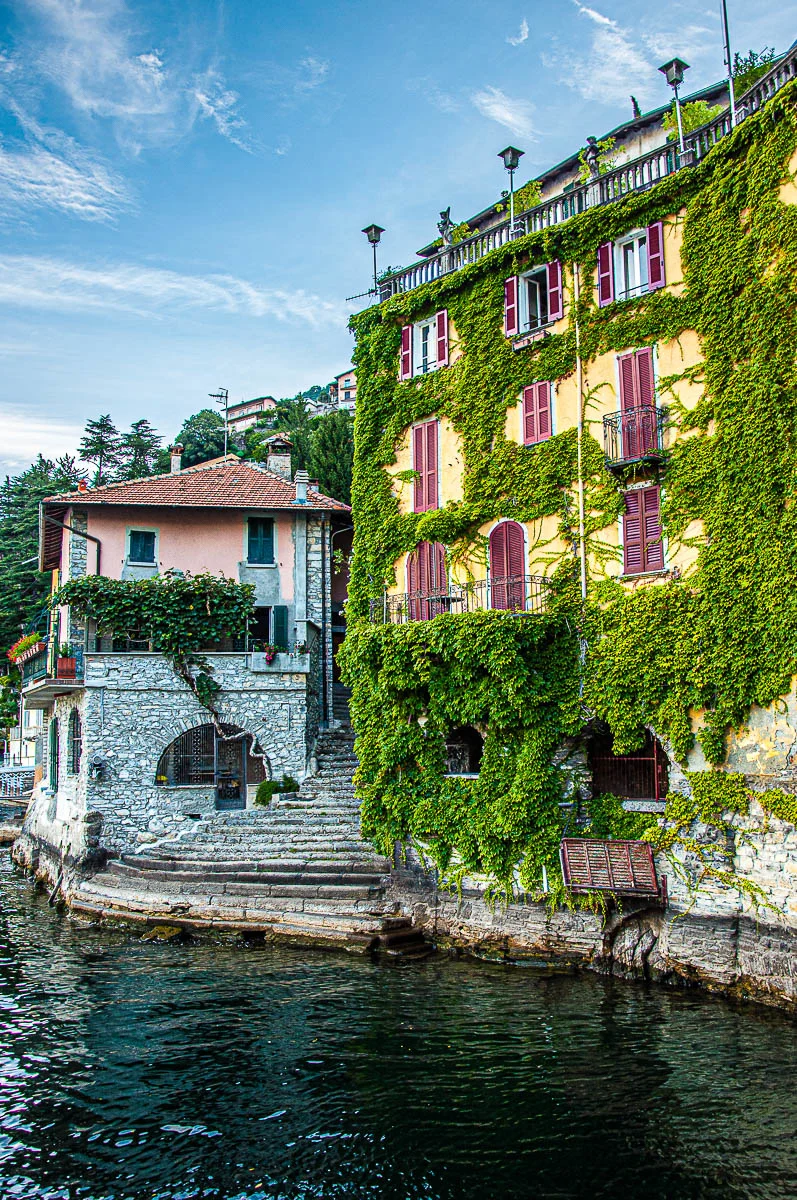
On account of its stunning landscapes and picturesque lakeshore towns, Lake Como is Italy’s most famous lake. For centuries, it has been attracting famous musicians, statesmen, and actors seeking to escape the pressures of daily life and to relax surrounded by beauty.
In the above blog post, I introduce you to Lake Como through my eyes with the help of 25 photos of iconic lakeside locations. Some are widely known whereas others are hidden gems that few discover for themselves.
From the town of Como to the tourist magnet of Bellagio, from tiny Nesso with its mighty waterfall to the colourful houses of Varenna, I show you Lake Como in sun and storm, in low and high season.
I hope that you enjoyed this little walk around Italy’s Lake Como!
More Helpful Links
- Experience Lake Como Web Story
- A Walk Through Nesso – The Prettiest Village on Lake Como, Italy
- Lake Caldonazzo, Italy – 10 Things to Do around Trentino’s Largest Lake
- The Beauty of Vicenza, Italy in 30 Photos and Stories
- Best 12 Towns to Visit around Lago di Garda – Italy’s Largest Lake
- Lake Garda with Kids or The Best 11 Things to Do at Lake Garda for Families
- Lake Garda Beaches – 16 Top Tips for a Great Day at the Beach at Italy’s Largest Lake
- 3 Unmissable Lake Garda Beaches to Sun Yourself on This Summer in Italy
- 8 Best Airports for Lake Garda or How to Quickly Reach by Plane Italy’s Largest Lake
Thank you for reading! Please, leave me a comment, pin the image below or use the buttons right at the top and at the end of this blog post to share it on social media.
For more useful information like this, please, like my blog’s page on Facebook and subscribe to my strictly no-spam newsletter.
